You have likely searched online for a new dentist before, typing something like “best family dentist.” The problem is that the results would have just as likely generated dozens of websites.
The next question comes naturally to practicing dentists: how can YOU make sure your dental practice stands out online and captures the attention of potential patients?
The answer lies in dental SEO marketing. This technique helps search engines understand your practice’s unique value and services. It also helps search engines display your content to the right people at the right time.
This step-by-step guide will teach you all about dental SEO. Get ready to learn how to attract a steady stream of new patients, grow your practice, and establish a robust online presence.
Key Takeaways
- Dental SEO improves your dental practice’s online visibility, website traffic, and patient trust. Growing your patient base this way is more efficient and cost-effective than traditional advertising.
- Focus on creating valuable content optimized for keywords. Make sure your service pages and blog posts answer patients’ common questions.
- Demonstrate expertise, experience, authority and trust (E-E-A-T) in your content.
- Prioritize local SEO by optimizing your Google Business Profile to ensure consistent NAP (name, address, phone number) listings across directories. Also, encourage patients to review your practice.
- Conduct regular website audits to identify and fix technical SEO issues. Improve user experience by establishing an intuitive navigation and responsive website design.
- Build your social media presence on platforms where your target patients are active. Share helpful tips, showcase testimonials, and engage with followers.
- Create informative and engaging video content optimized for SEO to educate patients. Give them a glimpse into your practice.
- Measure your dental SEO success with tools like Google Search Console, Google Analytics, and SE Ranking. Make on-page SEO checks, track keyword rankings, local SEO performance, and website health.
- Conduct SEO either by hiring a specialized dental SEO agency or learning to do it yourself with comprehensive SEO tools and educational resources.
What is dental SEO?
Dental SEO, or (Dental Search Engine Optimization) is about improving your dental clinic’s online presence to get greater reach on search engines. Dental SEO improves your practice’s website through keyword optimization, technical adjustments, and brand authority growth (following E-E-A-T guidelines). This increases your site’s visibility and attracts more qualified leads. When potential patients search for dentists or dental services on Google, Bing, or other search engines, a well-optimized website appears higher in search results. This increases the likelihood of users clicking through and choosing that practice.
Let’s say someone searches for “family dentist with teeth whitening in New York,” or “late-***** dental care.” By conducting SEO for dental clinics, you show Google or other search engines that your practice is the perfect match for searches like the ones described above. The goal of dental SEO is to earn Google rankings and appear at the top of those search results.
For example, check out the screenshot below:
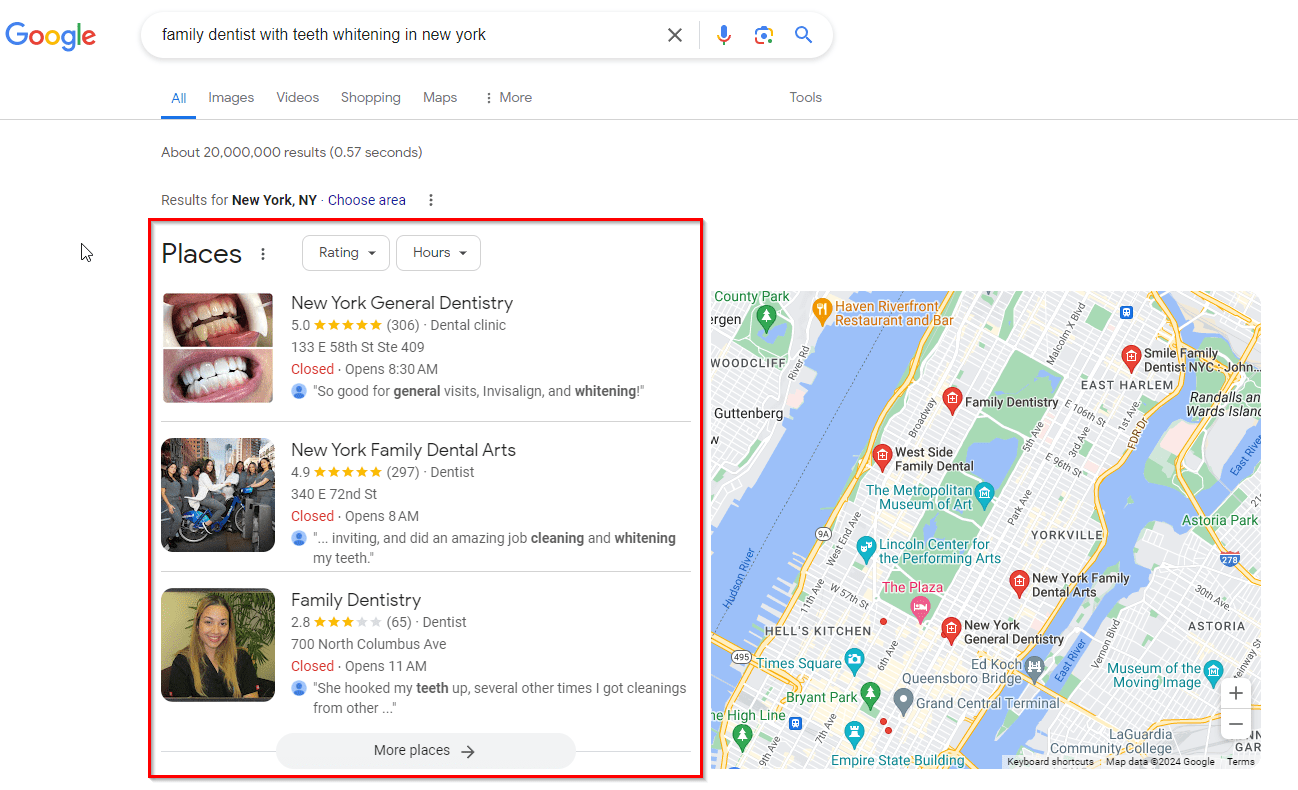
Here is another example (let’s say you search for “late-***** dental care”)

This helps you capture the attention of new patients precisely when they need you the most. Your website will appear at the top of their search results, providing them with all the info they need. Timings, services, address—everything is organized smartly. The great thing about dental SEO is that it works for any dental practice, regardless of size or location.
Why is SEO for dentists important?
The best way to answer this question is with real numbers and examples. Let’s use them to explain why dental SEO marketing is so important:
1. It improves online visibility & local awareness
According to SE Ranking’s Keyword Research tool, there are over 2.2M monthly searches for ”dentist near me” in the U.S. alone:
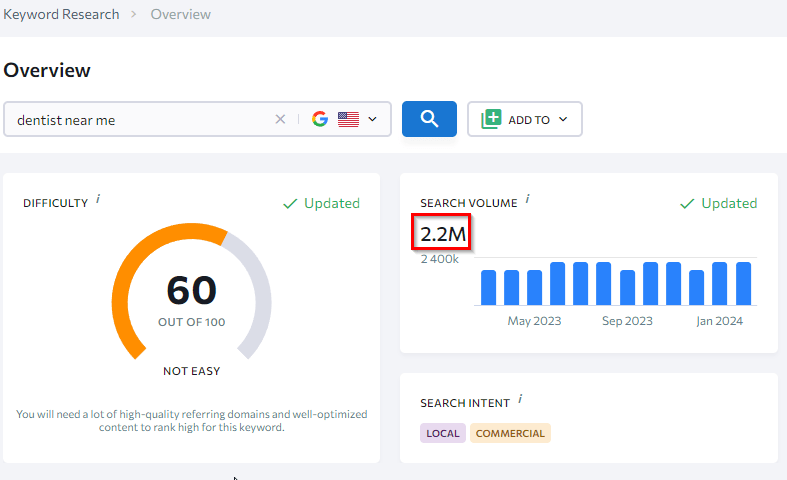
This is a massive **** of potential searchers looking for dental services! You can greatly increase your website’s visibility in local search results by targeting other relevant keywords like “dentist in Los Angeles,” “dentist in Chicago,” “dental care Houston,” “dental office near me,” or “best orthodontists near me.”
Ranking higher increases the chances that these potential patients will find you.
Rising above your main competitors in ranking requires you to conduct SEO for dentists with care and precision. We will explain how to do this in the following sections.
2. It increases website traffic
The screenshot below shows that improved online visibility and local awareness translate to more overall website traffic on your website:
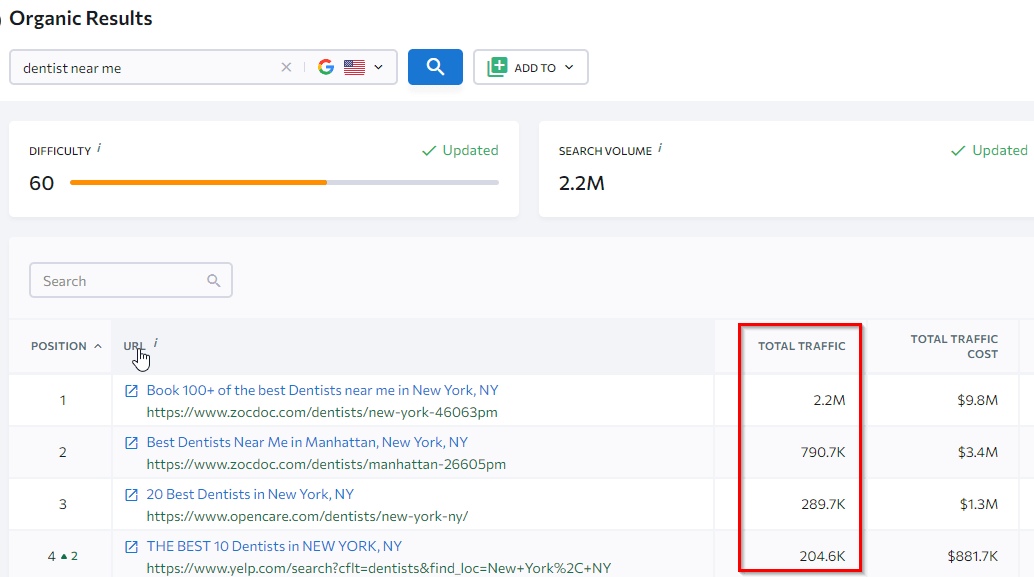
3. It turns clicks into appointments
Backlinko conducted a fresh study showing that the top organic search result receives a whopping 27.6% of clicks, with 2.4% decreasing dramatically for lower rankings. In particular, performing SEO for dental clinics helps you capture those valuable clicks, turning cold online searches into actual patients.
4. It builds trust and credibility
Having a robust SEO strategy is a surefire way to establish yourself as a dental authority. Imagine someone searching for “dental implants near me.” You can leverage informative blog posts and positive patient testimonials to convince searchers to choose your practice over your competitors’!
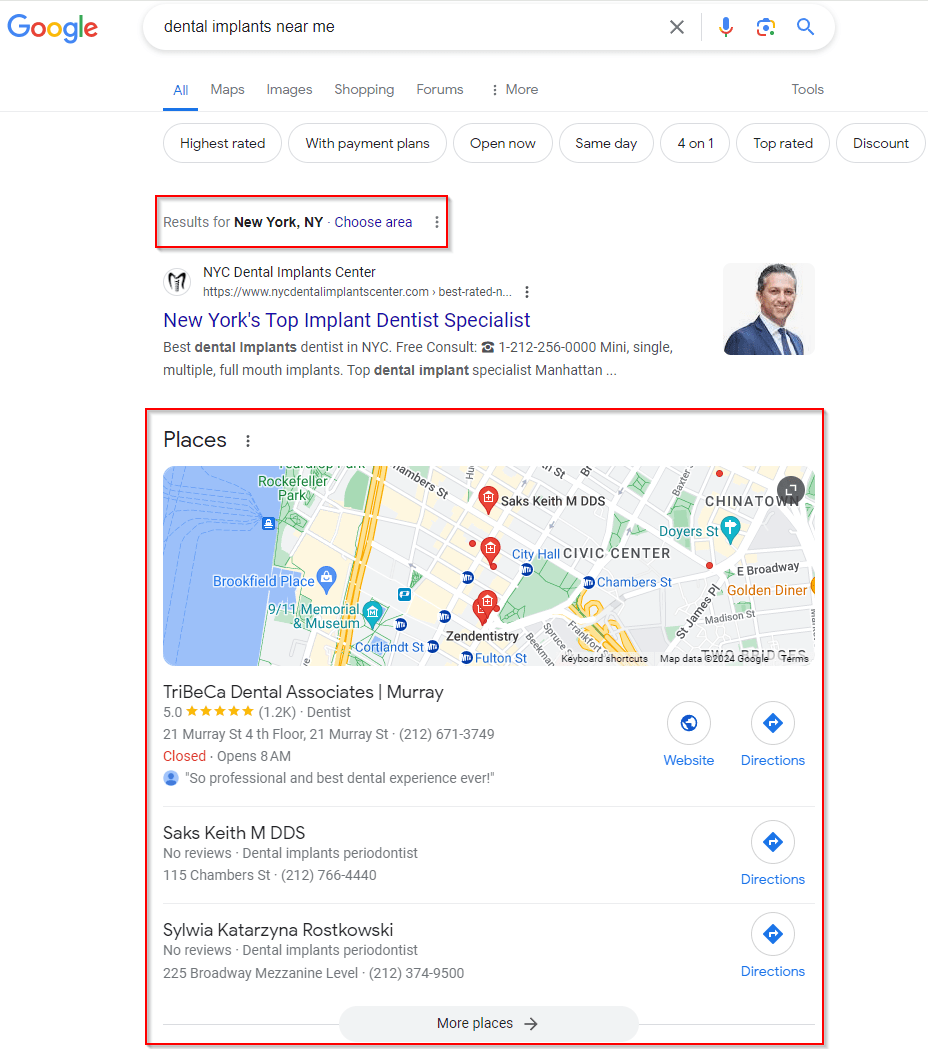
5. It expands your patient base
Performing SEO for dentists is no quick fix. It’s a long-term process. As your website ranking improves, you’ll eventually attract a steady stream of new patients. This is a form of organic growth. Focus on providing excellent care so your current patients actively vouch for you. Patients who are already happy are your greatest advertising assets.
6. Requires lower costs
While SEO requires ongoing effort, it’s a more cost-effective way to reach potential patients than traditional advertising methods (e.g. paid ads or radio spots). The end result is that you not only get greater reach by paying less, but you also pay for tangible long-term results for your business.
How to do SEO for dental practices
Dental SEO is built upon the core principles of regular SEO but with a laser focus on attracting patients in your local area. This means you should prioritize local SEO techniques and building trust (following E-E-A-T guidelines). You can achieve this by creating high-quality, dental-specific content.
Create SEO Content
Content SEO is a fundamental aspect of dental SEO. It involves creating valuable content that attracts patients searching online for the kinds of services you provide. It also helps you build trust in your practice. But how exactly does it work? Let’s break it down:
Identify all relevant keywords to dentistry, dental services, and local searches, e.g., “dentist + [city].”
Keywords are the words or phrases that potential patients use when searching for dental services online. You can attract the right audience to your website by identifying and targeting the most relevant keywords for your practice.
Start by brainstorming terms related to dentistry, specific services you offer, and your location. For example, here are some potential keywords to include if you’re a dentist in Los Angeles offering cosmetic treatments:
- “dentist in Los Angeles”
- “cosmetic dentist Los Angeles”
- “teeth whitening in Los Angeles”
- “dental implants Los Angeles”
You can also do keyword research with specialized tools to find popular search terms and relevant phrases related to your practice. For example, try SE Ranking’s Keyword Suggestion tool to uncover more keyword ideas.
This tool also provides you with valuable insights, including:
- Keyword Difficulty (KD) – The score (usually out of 100) indicates how difficult it is to rank well for a particular keyword.
- Search Volume – The average number of monthly searches for that keyword. This helps you prioritize keywords with balanced search volume and competition.
- Search Intent – Indicates the user’s goal behind the search. Are they looking for general information, specific services, or reviews? Understanding intent allows you to tailor your content to their needs.
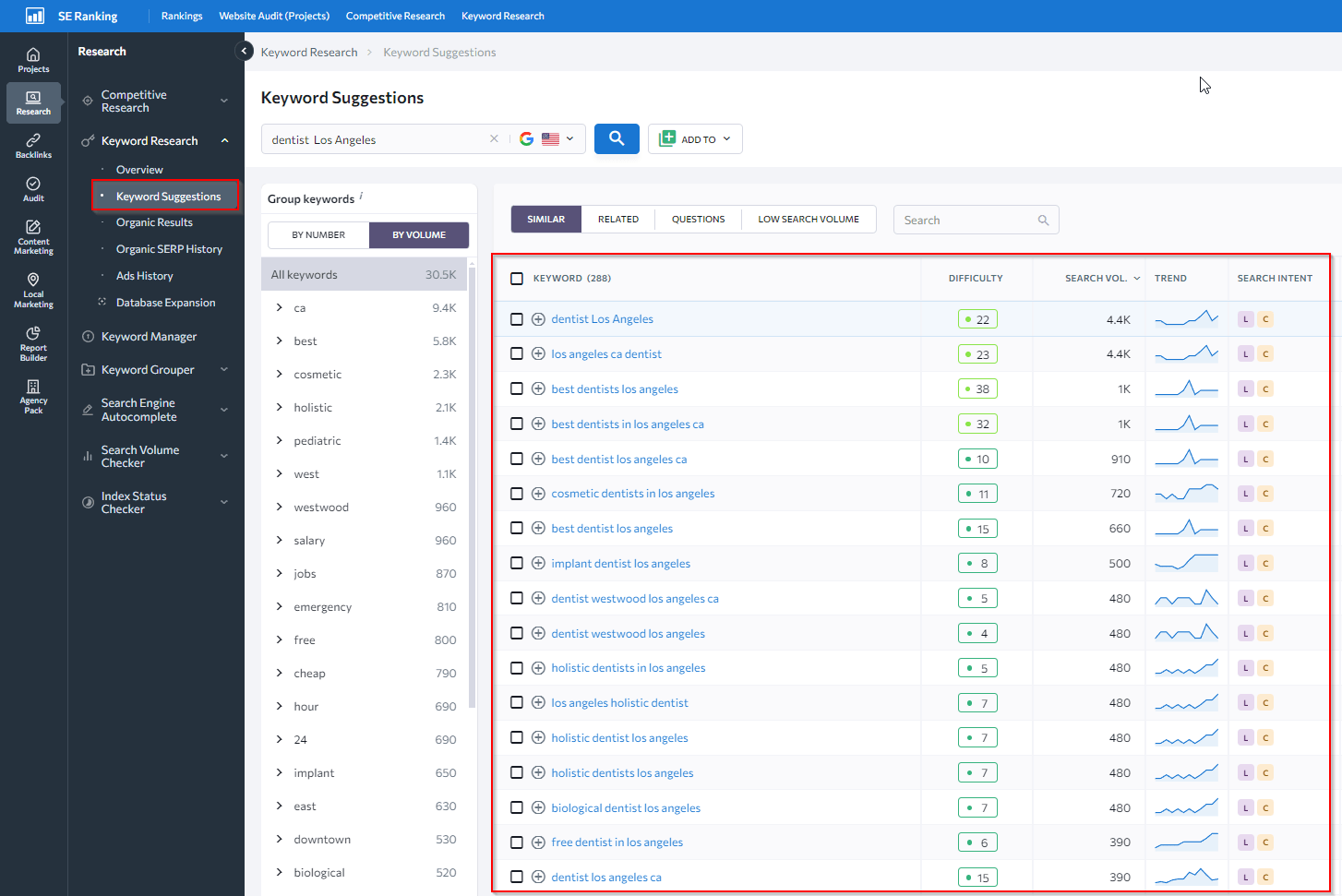
For more in-depth information on this topic, explore our detailed guide on how to choose the right keywords to target.
Another great way to find keyword opportunities is by observing quality websites of other dental practices in your area to discover their targeted keywords. This helps you understand how they get traffic from search engines and which keywords work best for them.
SE Ranking’s Competitive Research Tool is great for this purpose. For example, let’s specify LA Dental Clinic as your hypothetical competitor. Since it ranks first on Google, let’s look at its primary keywords and traffic data.

In the Organic Traffic Research tab, you’ll find a comprehensive list of your competitor’s web pages next to key metrics like traffic share and keyword count. Sort its pages by total traffic to quickly find its most popular content.
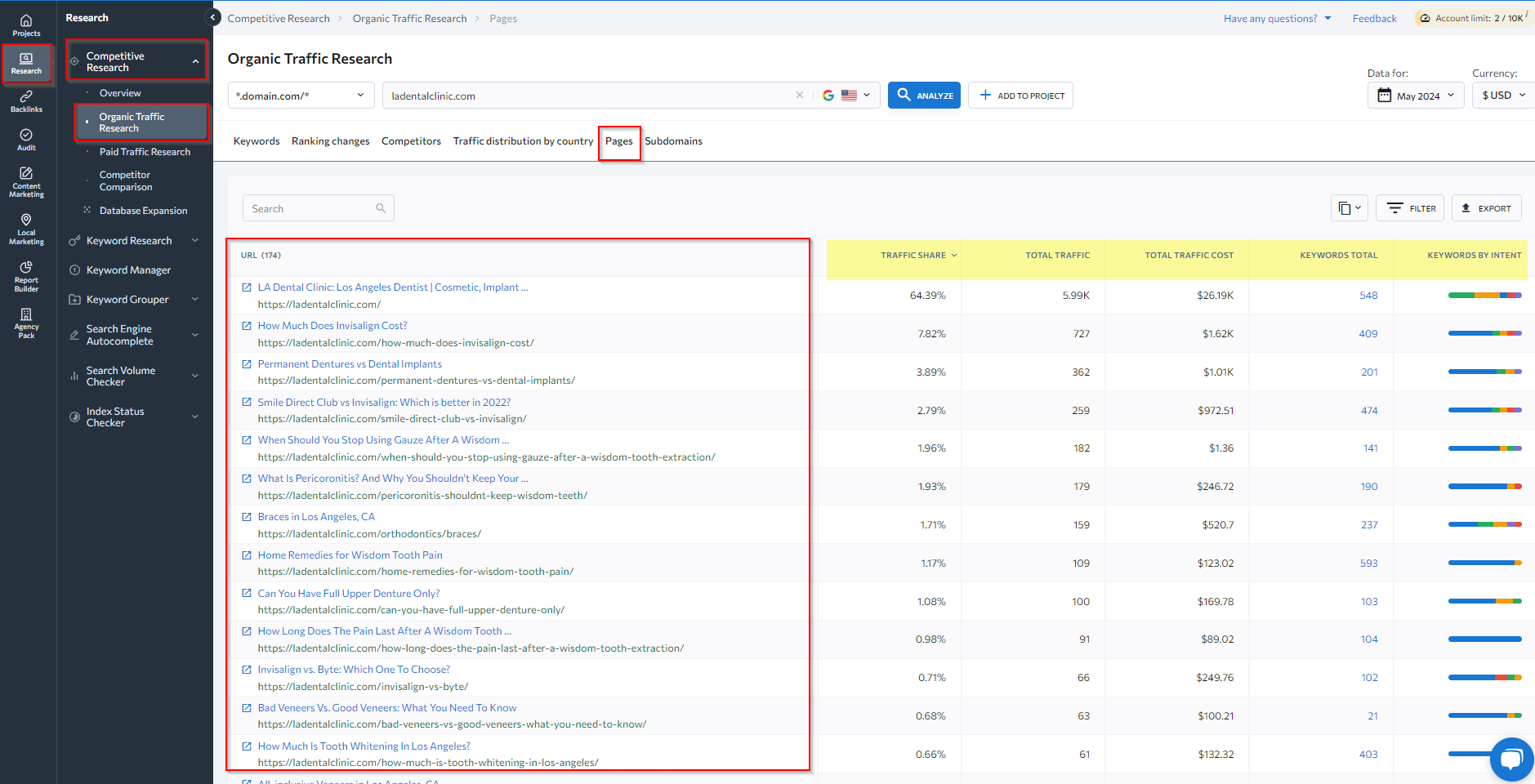
Go to the Keywords tab to observe any distinct keywords targeted by your competitors. It also shows you how well each keyword performs. This data can help you find good keyword opportunities and evaluate the competitiveness of various terms within the dental industry.
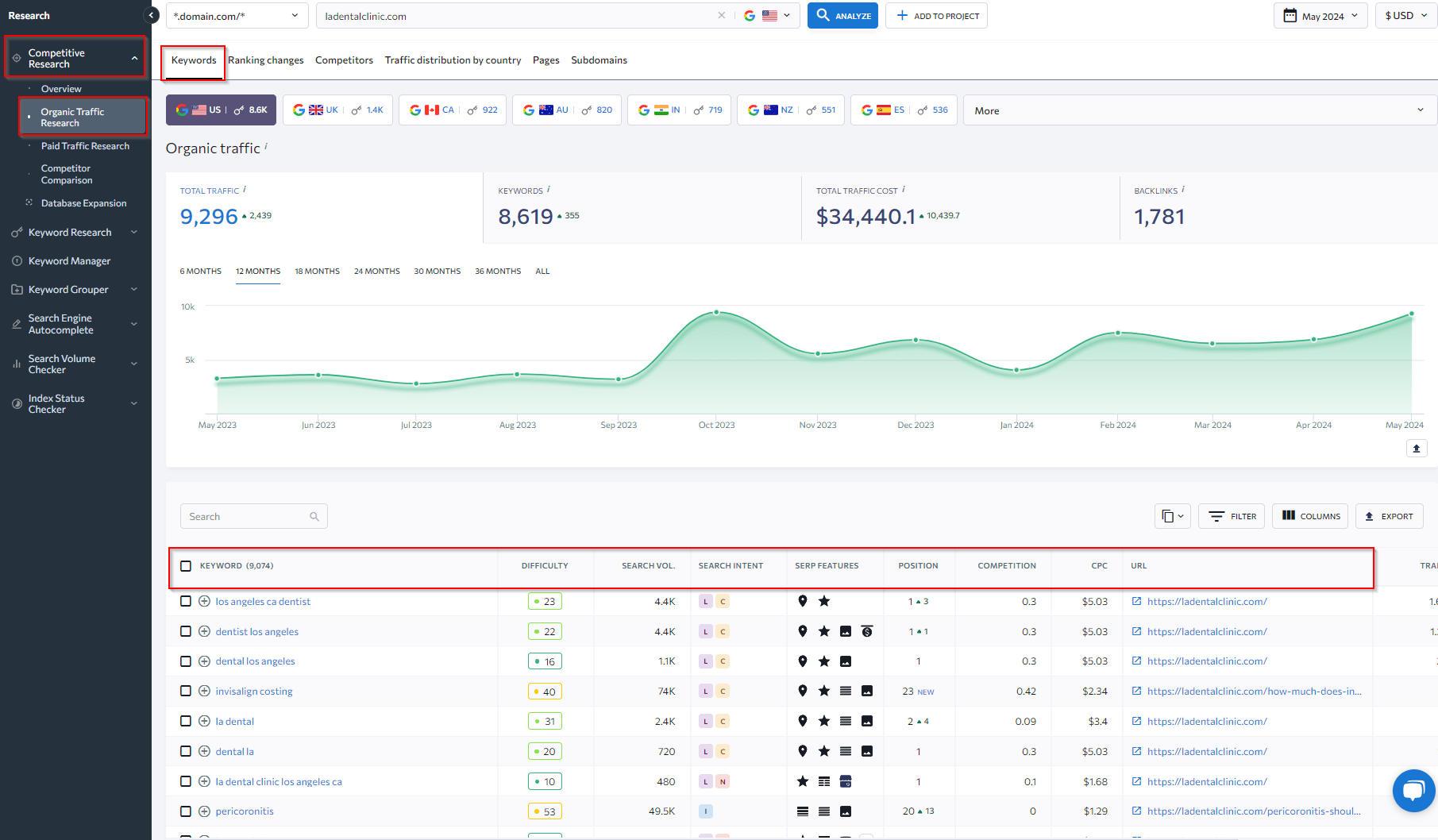
If you’re not sure who your competitors are, enter your website into the field. Navigate to the Competitors tab for a comprehensive list of your top organic competitors.
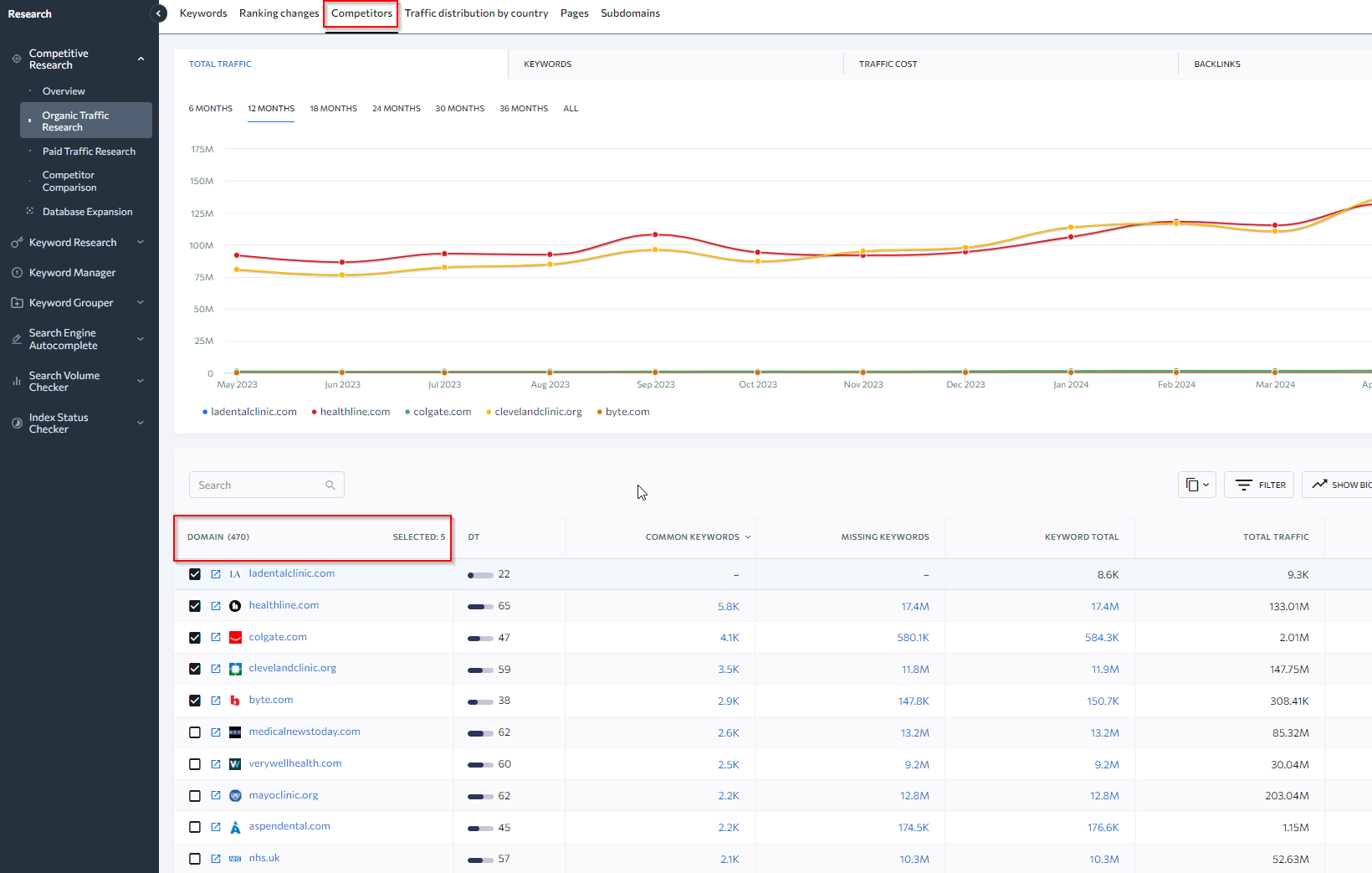
Integrate relevant keywords organically throughout your dental website
Now that your keywords are ready, it’s time to weave them throughout your content.
Grouping your keywords into relevant clusters is the most effective way to accomplish this. Keyword clustering involves grouping similar keywords based on semantic relevance and search intent. This helps you create content that comprehensively covers a topic and appeals to your target audience.
Once you’ve grouped your keywords, prioritize these clusters based on their potential business impact. This helps you prioritize the most valuable keyword opportunities first.
Always integrate keywords into your content naturally. Be strategic in their placement and never stuff your content with keywords. The key is to ensure all keywords spread throughout your content read naturally and provide real value to your visitors.
Create landing pages for the dental services you provide
This might include services like teeth whitening, dental implants, wisdom teeth removal, etc. Let’s use the LA Dental Clinic (ladentalclinic.com) example again. They have a page about veneers that ranks at the top of Google for “veneers cost Los Angeles.” That is pretty impressive, especially considering that that keyword gets searched approximately 480 times a month.
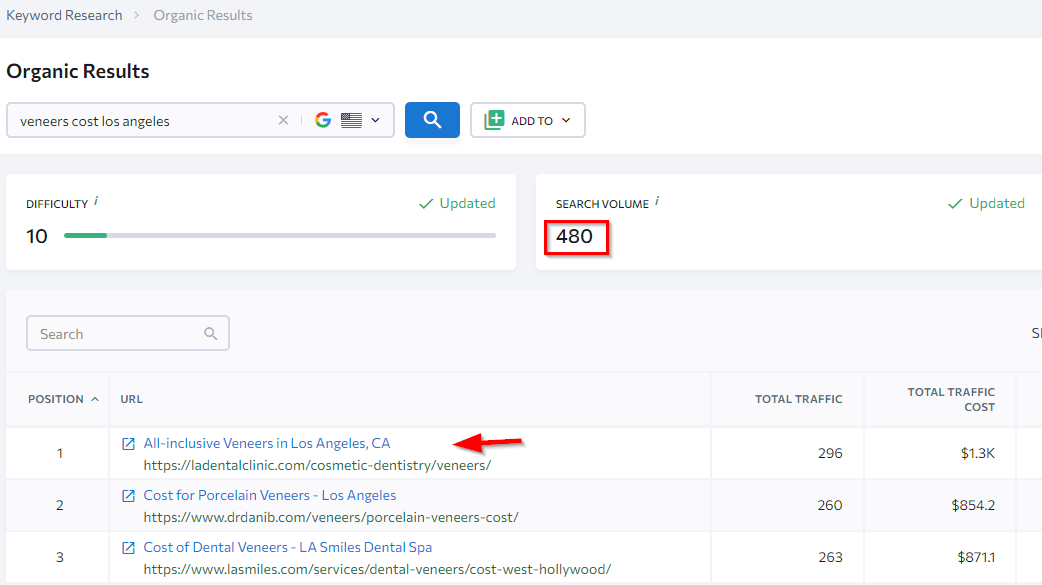
This clinic also has dedicated landing pages for each type of service it provides. Its services include general dentistry, cosmetic dentistry, restorative dentistry, orthodontics, etc.
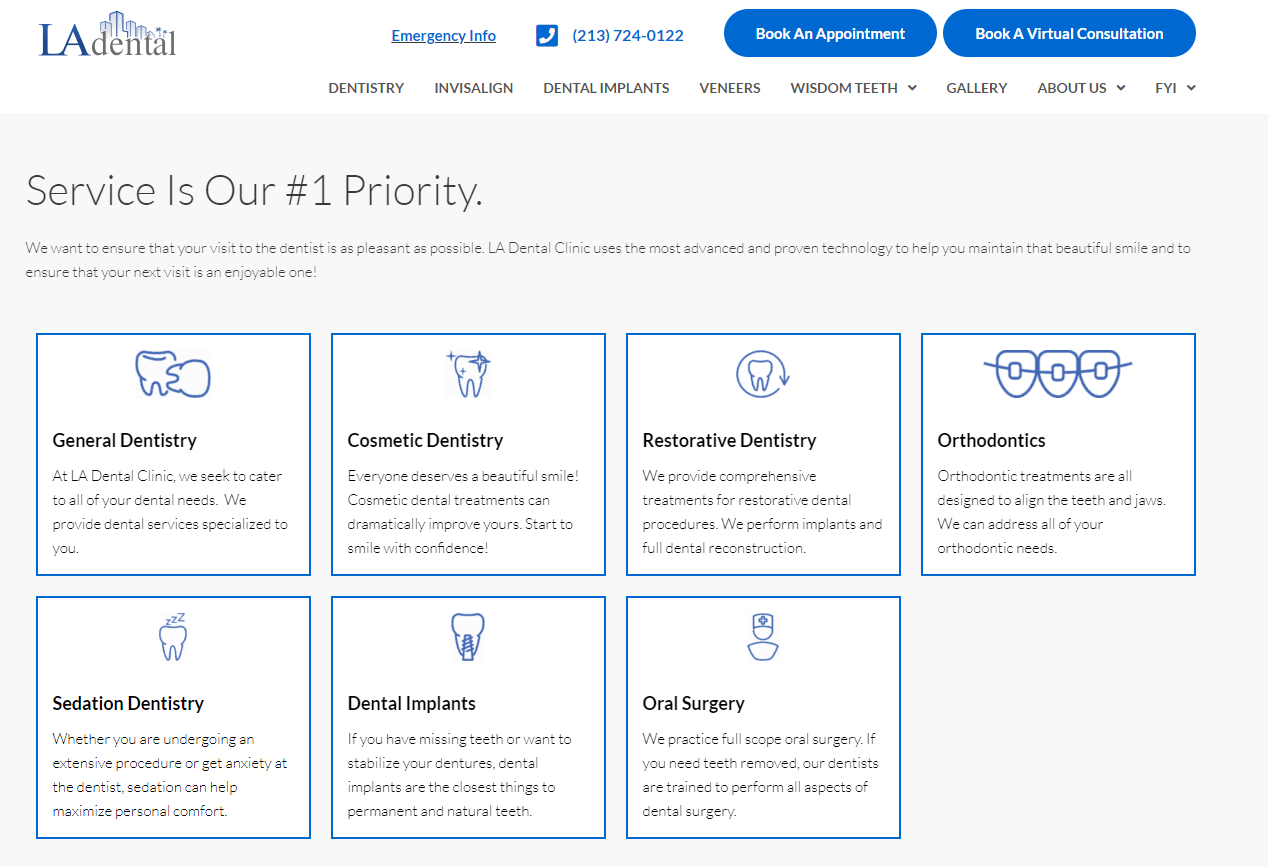
To offer highly relevant information to potential patients interested in each service, LA Dental Clinic has organized its services into specific procedures, each with a dedicated page. These pages not only provide a comprehensive overview of the procedure but also include information on the types of procedures offered within each main service category. See the screenshot below for example:
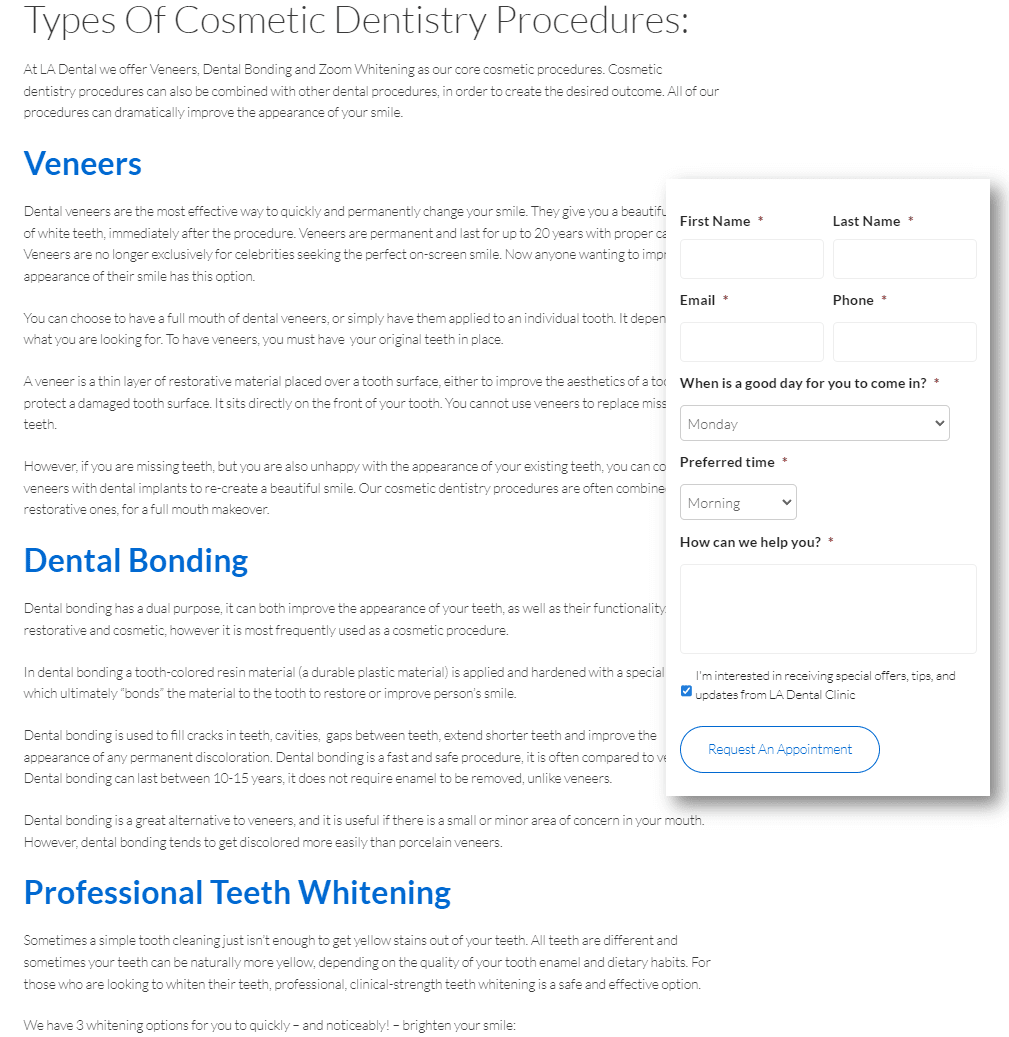
Write blog posts to answer popular questions
Blog posts are another great way to attract potential patients. Think about the questions people ask about dental care (e.g., what are veneers, how to brush teeth with braces, how much does invisalign cost). Then create informative blog posts that provide the answers they’re looking for.
LA Dental Clinic also has an effective content SEO strategy. Their blog tackles popular questions like “how much does invisalign cost” and ranks #1 for the keyword “invisalign cost Los Angeles”.

This blog post educates potential patients, making them more likely to choose LA Dental Clinic when they need that service.
Writing comparison pages is also important. Comparison pages help patients choose between treatments. For example, look at LA Dental Clinic’s page on permanent dentures vs. implants.

A deeper dive into LA Dental Clinic’s organic traffic shows that this page ranks #1 for the keyword “permanent dentures vs dental implants” and gets around 390 monthly searches. Optimizing content for this keyword helps patients make more informed decisions and attracts more of them to the clinic’s implant dentists.
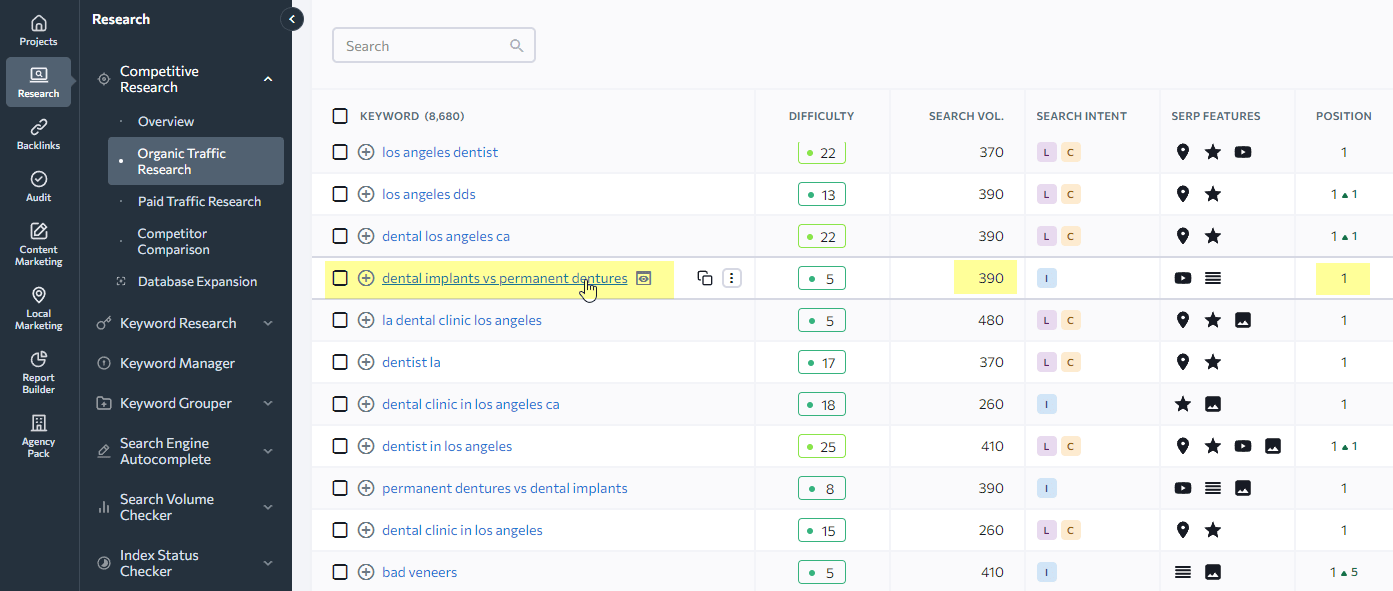
Plenty of other dental practices are also nailing their content SEO strategies.
Dentologie’s website in Chicago (dentologie.com) ranks first for “dentist chicago,” with 8100 average monthly searches. Houston Dental Care’s site also tops the charts for “houston dental” with 8000 average monthly searches.
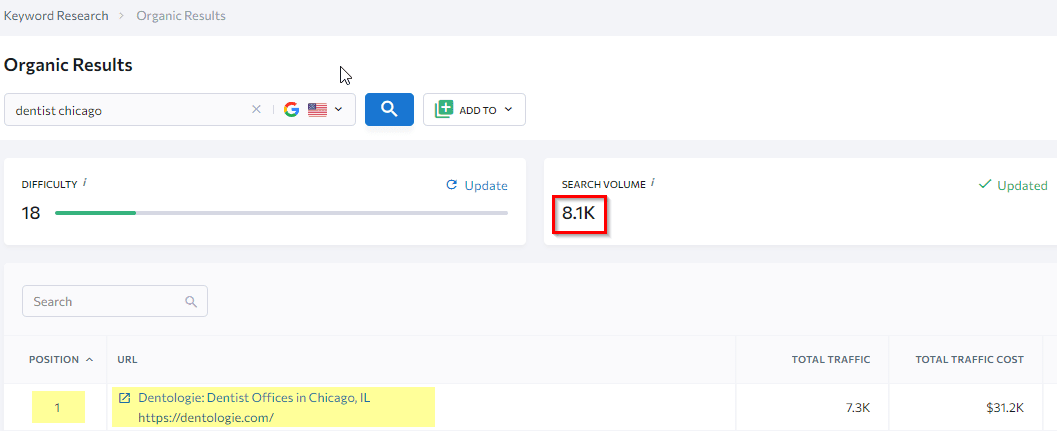
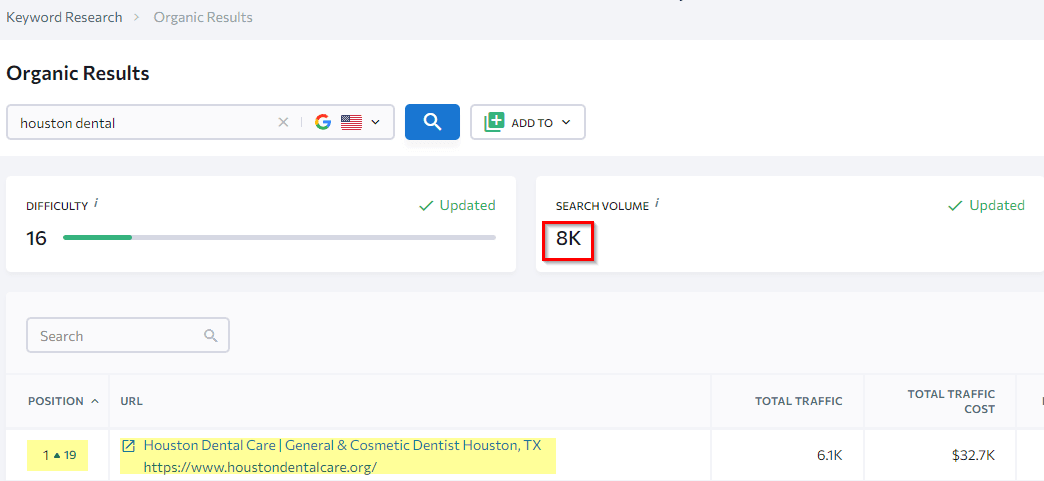
As you can see, content SEO is a must-have for all dental practices big and small. You can’t stand out online without it.
Demonstrate Experience, Expertise, Authoritativeness, and Trustworthiness (E-E-A-T)
Google rewards websites that produce high-quality content, especially those containing healthcare information. Google assesses this quality and value using its E-E-A-T (Experience, Expertise, Authoritativeness, and Trustworthiness) concept. This is even more important for YMYL (Your Money or Your Life) topics like dentistry, where users’ health is directly impacted by the information they find. Here are some key dental SEO tips for demonstrating EEAT on your website:
Highlight your Expertise and Experience
Accomplish this by:
- Displaying your practice’s accreditations. If your practice has dental degrees, certifications, and memberships in professional organizations, proudly display them on your website. LA Dental Clinic is a great example of this:

- Showcasing your team and their qualifications. Create a separate page for each doctor on your team—another technique used by LA Dental Clinic.
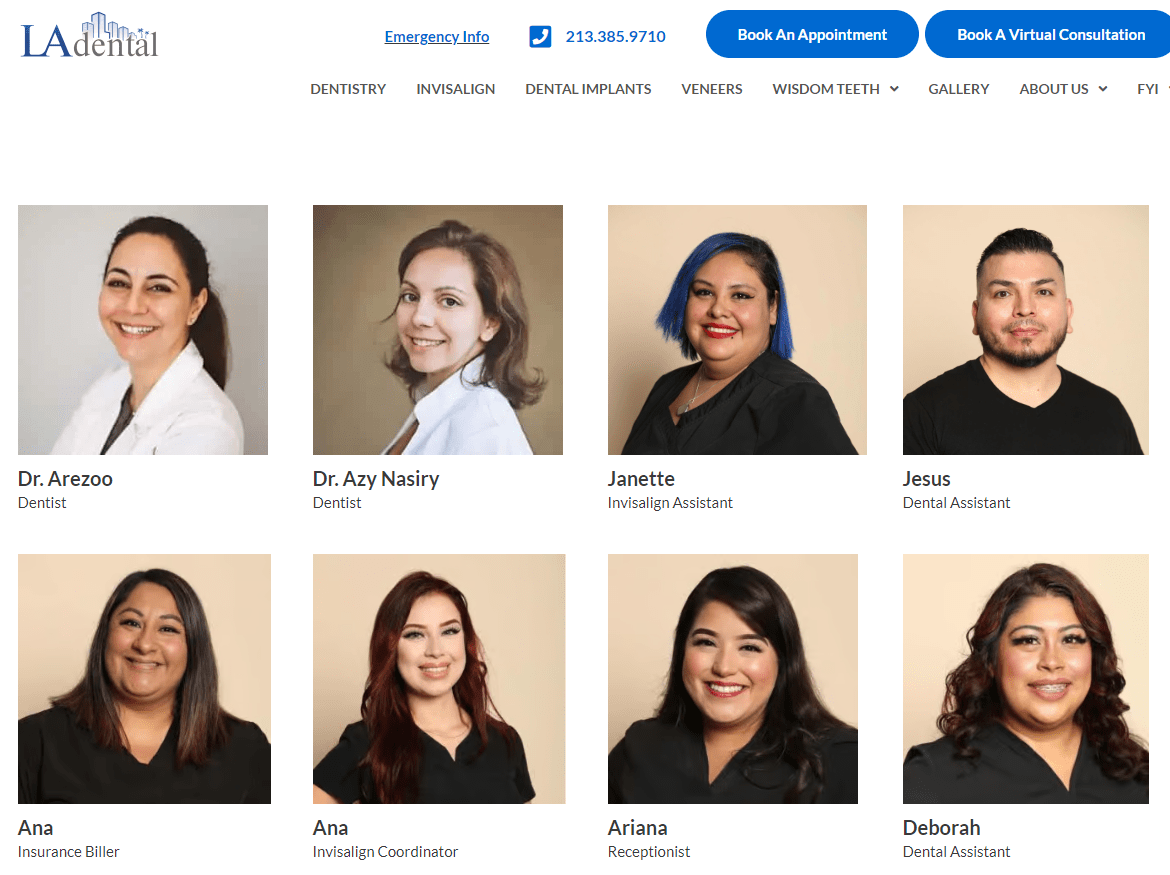
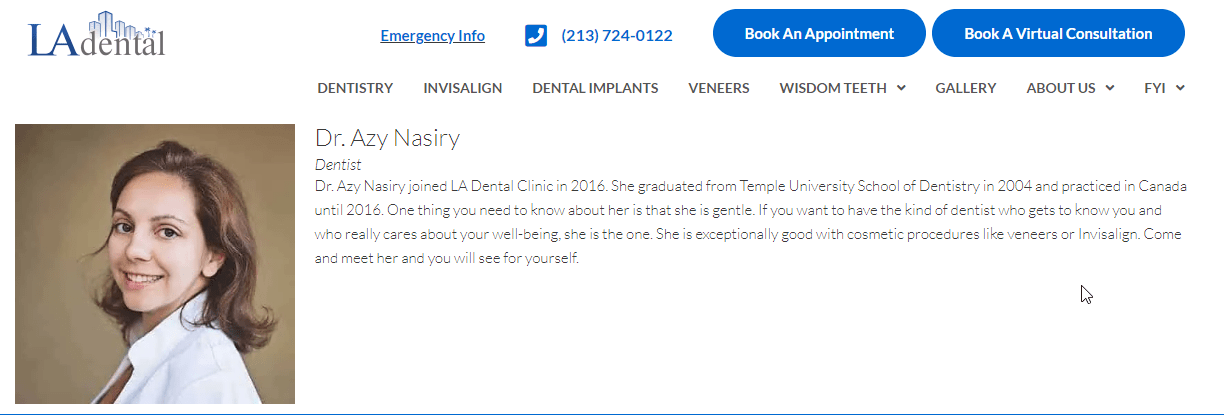
This allows potential patients to familiarize themselves with the faces behind the practice, making them feel more comfortable trusting you with their dental needs.
Build Authoritativeness
Accomplish this by:
- Creating professional content verified by experts. This might include blog posts, articles, or even videos covering dental topics relevant to your patients’ concerns. You can double down on your credibility by having these posts reviewed by dental professionals. This positions your practice as a reliable source of dental information. LA Dental Clinic’s blog content follows this best practice to a tee.
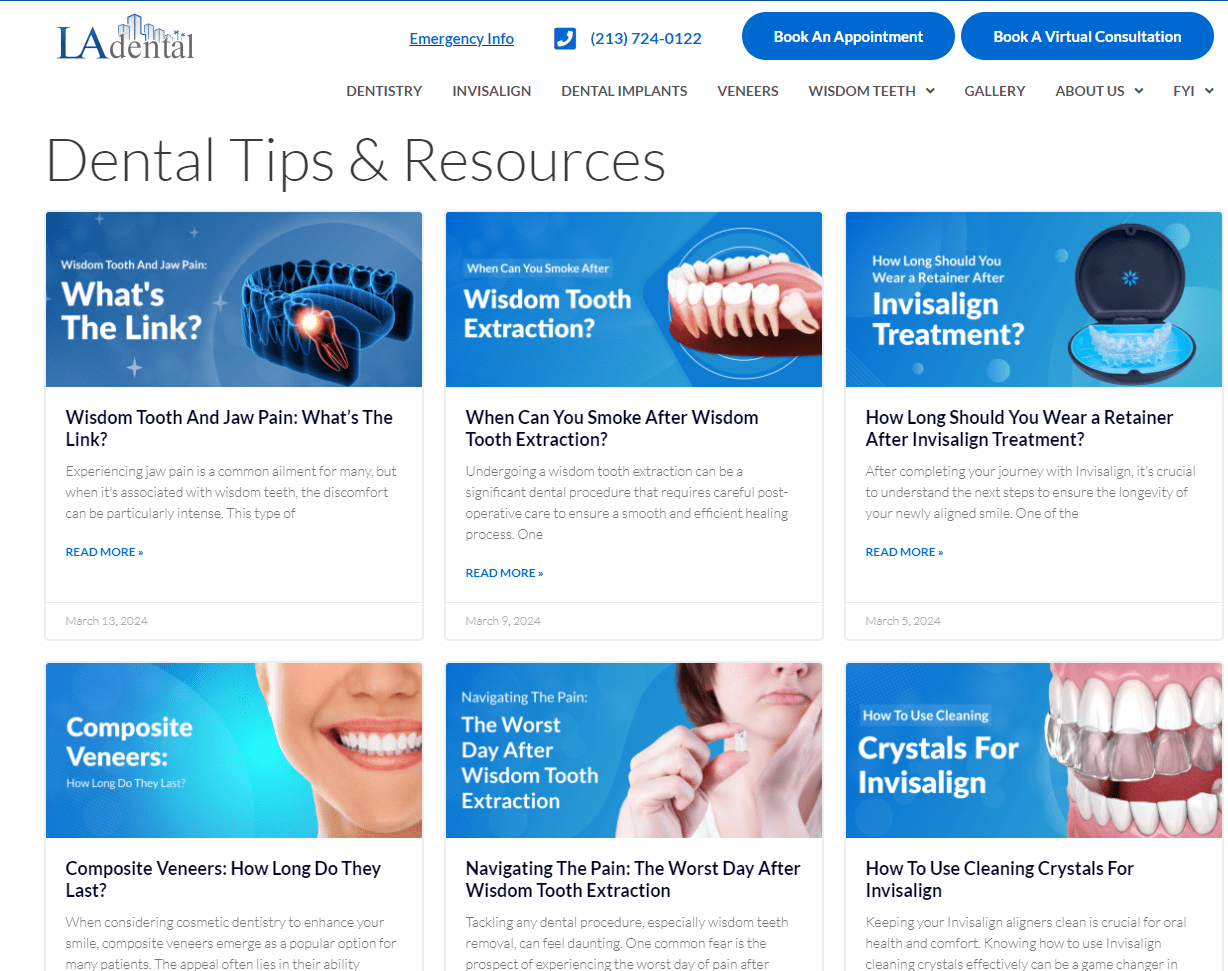
- Creating proof of patients’ results. Visual proof speaks volumes! Create a gallery that showcases real patient results. This offers a visual demonstration of the team’s skill and experience, helping to build trust and authority.
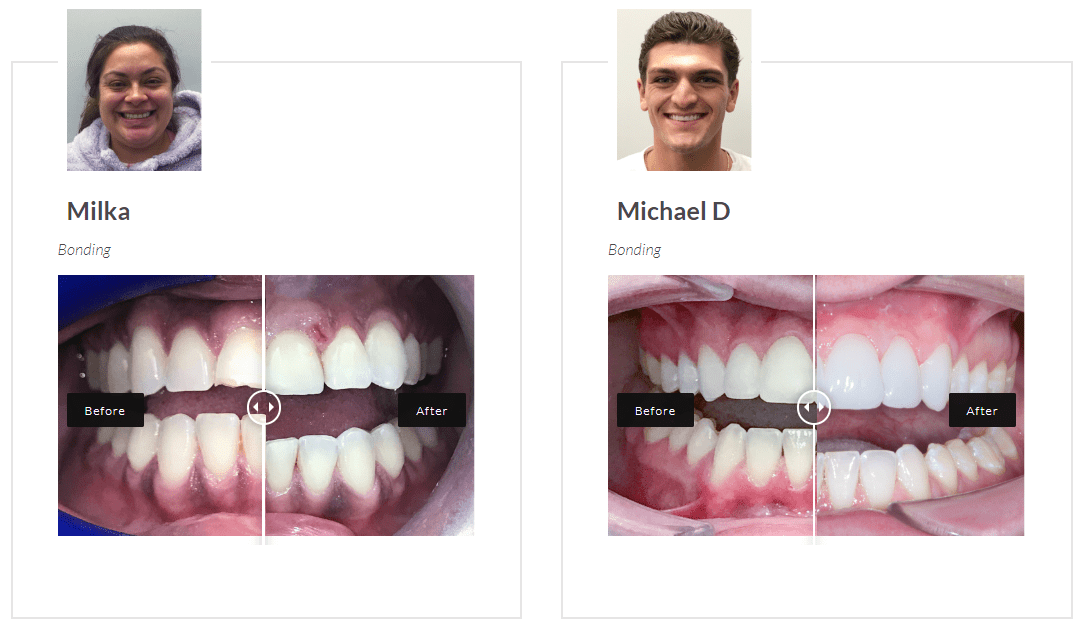
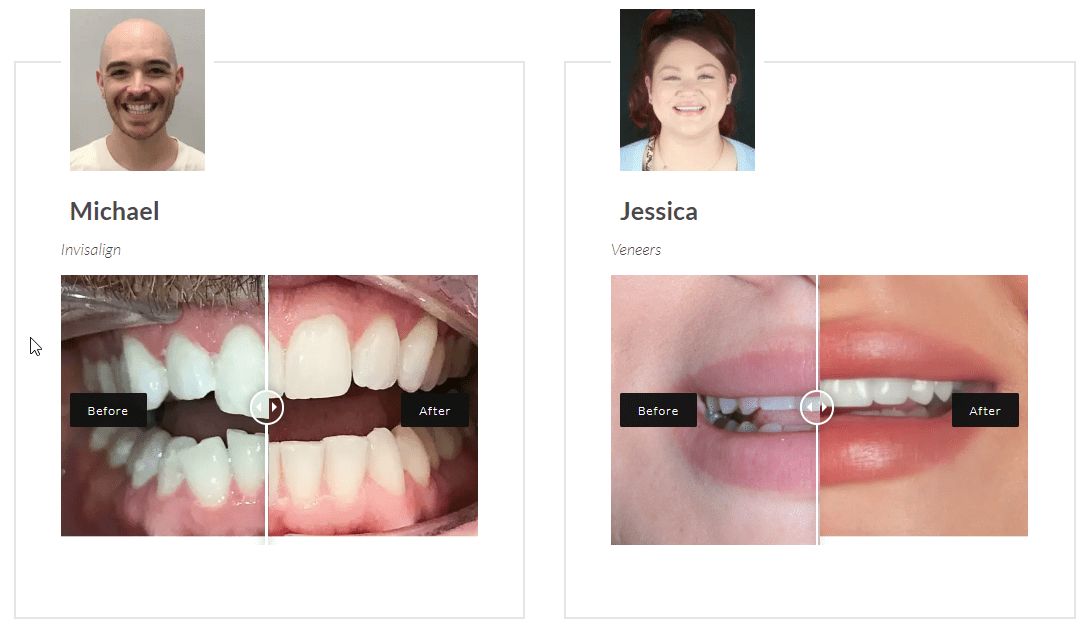
- Earning backlinks (links from other trusted sites) in the dental niche. When other trusted websites link back to your content, it’s like receiving a vote of confidence that says your site holds authority. This can greatly boost your SEO by increasing referral traffic and improving your ranking in search results.
While some backlinks might come naturally, you can manually boost your SEO with the following link building strategies.
- Publish content others might want to reference, such as original research, all-inclusive guides, and videos showcasing your expertise.
- Create guest posts by writing articles for established sites. This expands your reach and often results in a link to your website to boost your SEO.
- Get partners’ backlinks. Reach out to companies that offer complementary products or services. These might include dental care brands, toothpaste manufacturers, or dental equipment suppliers. Offer a partnership where you promote their products or services on your website in exchange for a backlink to your practice. Consider writing a blog post reviewing their products, hosting their banner on your site, or mentioning their company in your resources section.
Just remember, Google has its eyes peeled for link spam. Always play by the rules and follow the search giant’s link spam policies. You won’t run into trouble if you focus on getting links from high-quality, relevant websites that Google trusts.
Earn Trustworthiness
Accomplish this by:
- Highlighting positive reviews. Encourage satisfied patients to leave reviews on your website. This is another best practice used by LA Dental Clinic. Positive reviews help to build trust with potential clients by showcasing the positive experiences of others who have visited your practice.
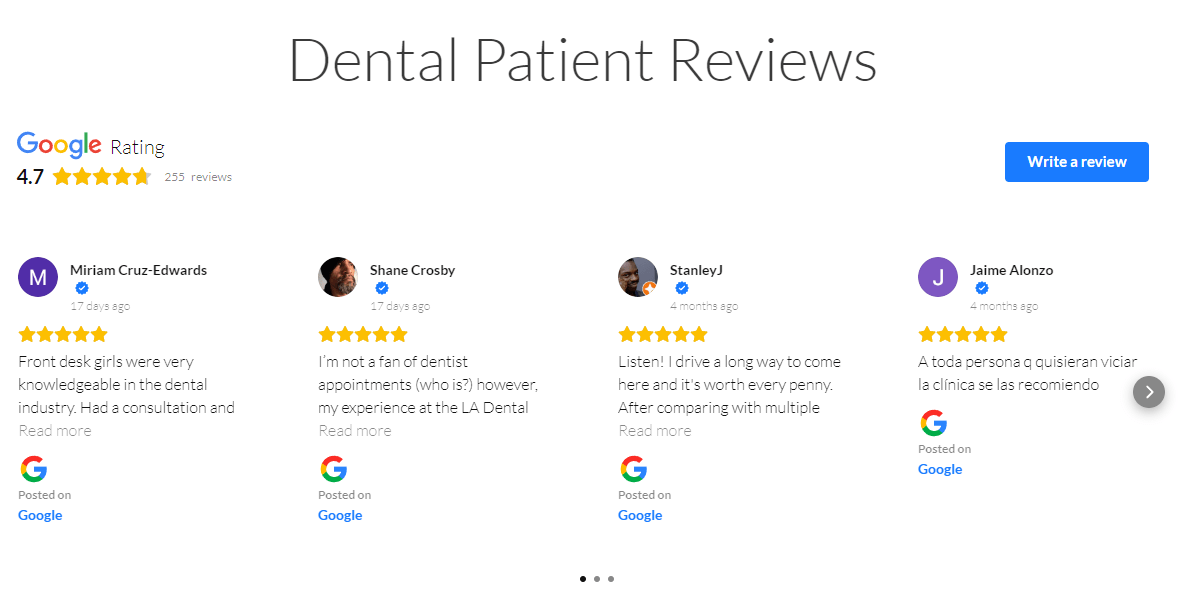
- Listing insurance information. Listing accepted insurance plans on your website in a straightforward way is key. It shows that you’re transparent and committed to making dental care accessible and affordable for your patients.
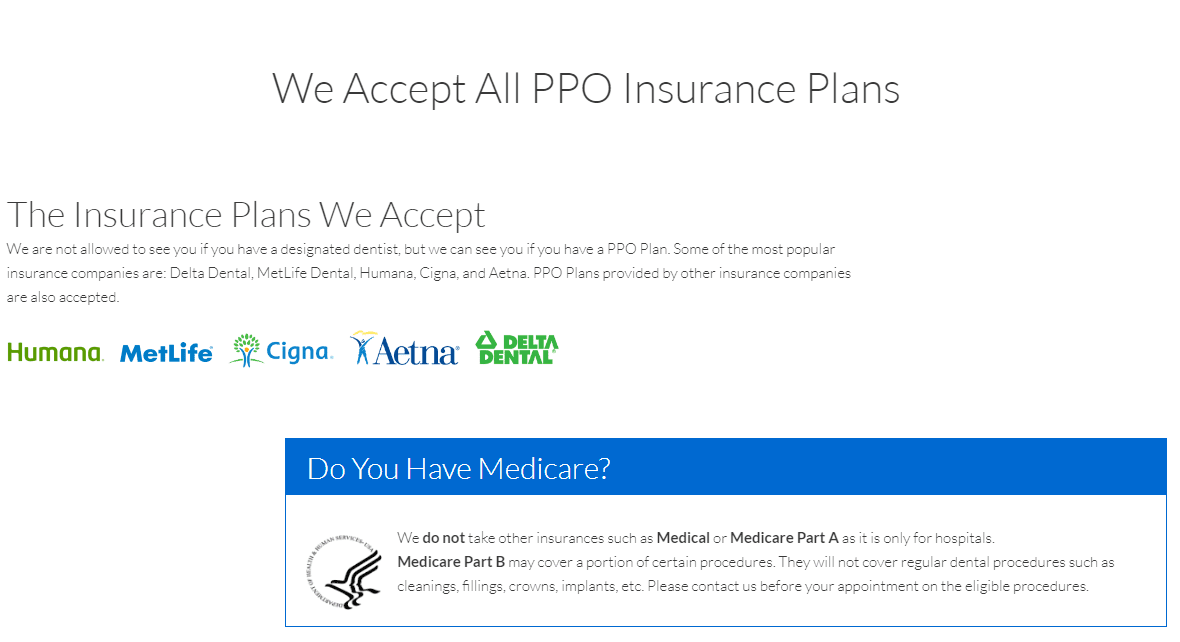
Prioritize Local SEO
Performing local SEO for dentists is crucial for offline dental clinics. Here’s how to dominate local search results:
Create and optimize a Google Business Profile for your dental practice
This free tool lets you manage how your dental practice is presented on both Google Search and Google Maps. See the screenshot below for reference:
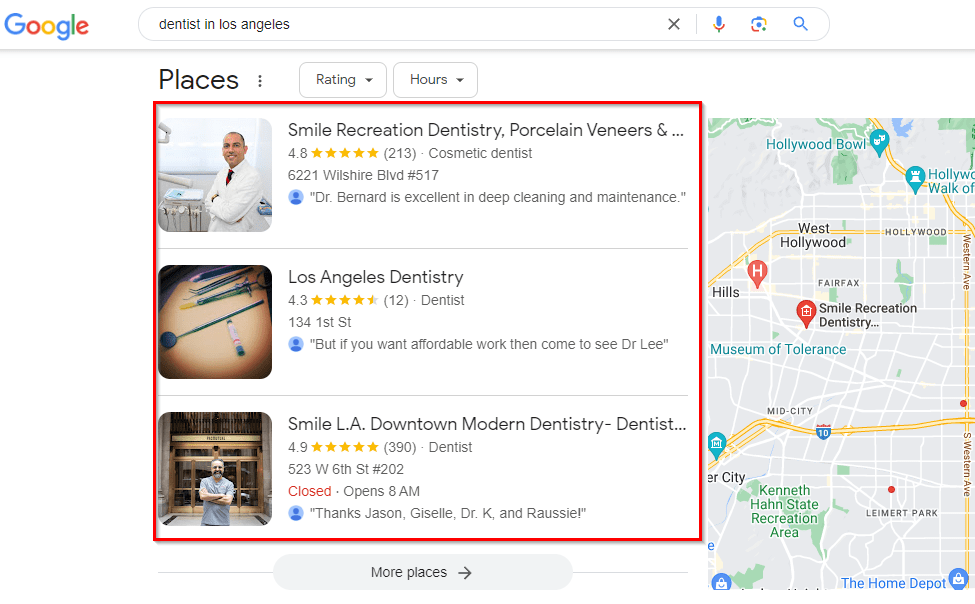
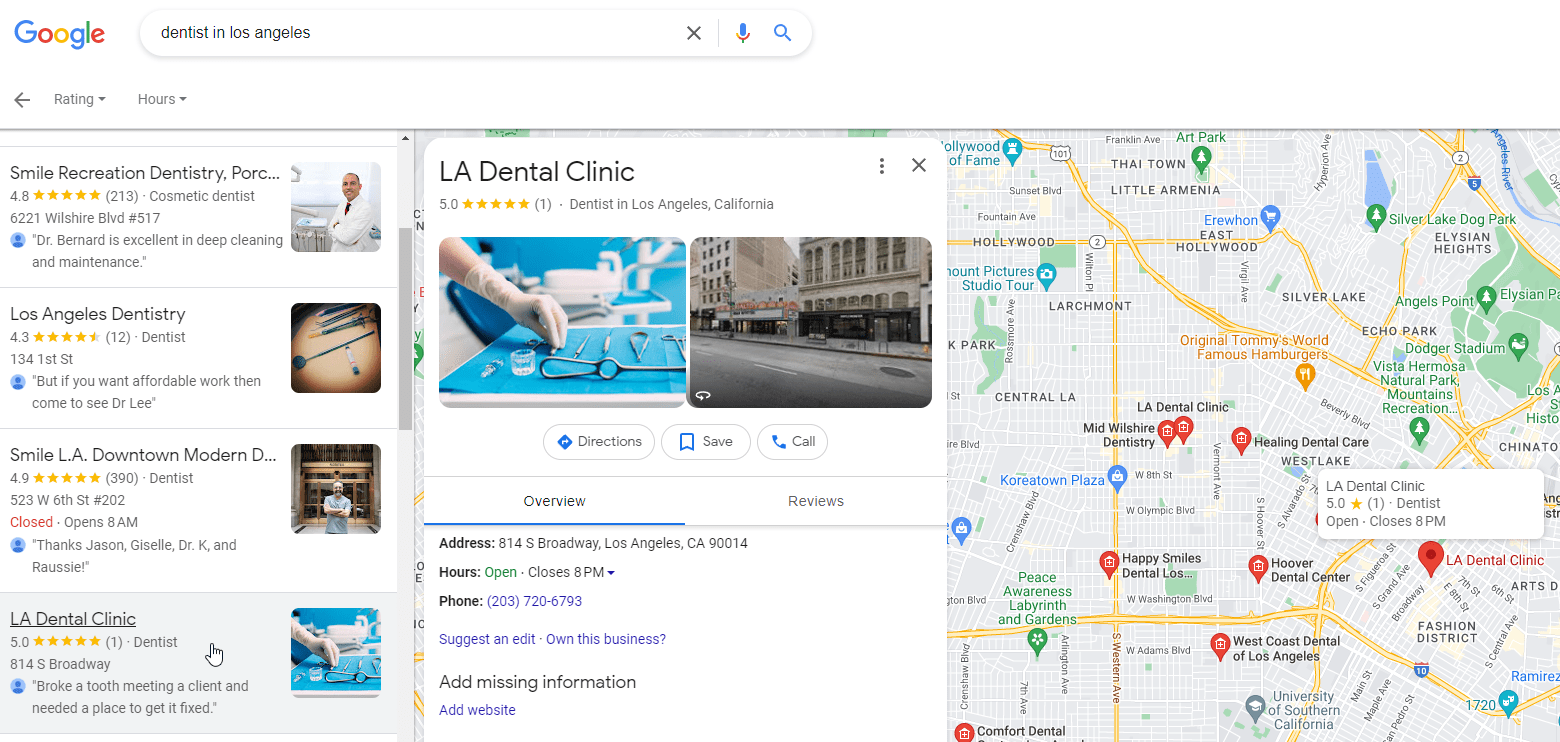
Also, be extra attentive when verifying your Google Business Profile. It isn’t just a formality; it’s a way to manage your business information across Search, Maps, and other Google features once Google confirms your business location and ownership.
Ensure all your business information is accurate and matches information listed elsewhere online
This includes NAP (Name, Address, Phone number) and business hours. An optimized Business Profile makes it easy for potential patients to find all the important details about your practice. See the screenshot below for reference:
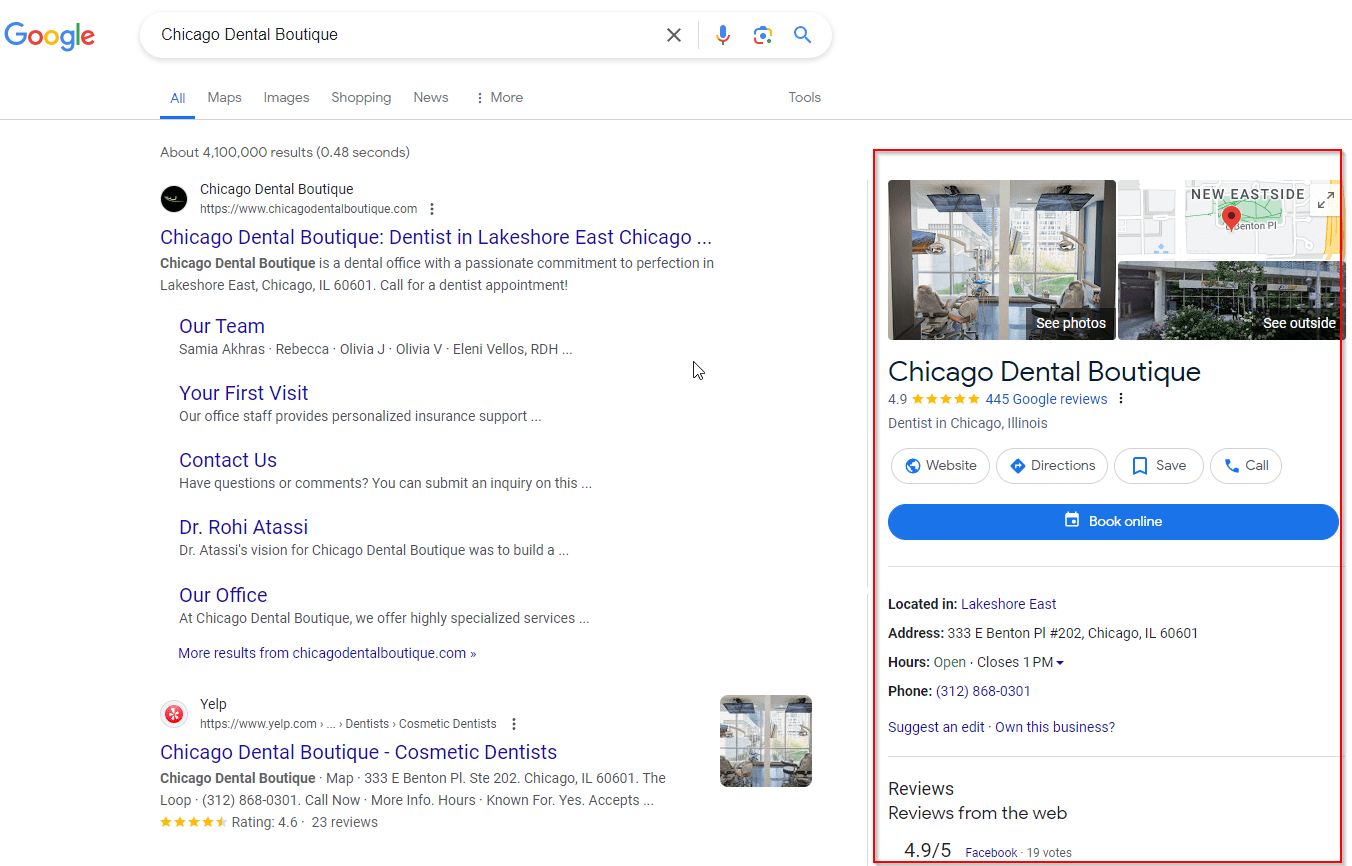
Get your practice listed on trustworthy online directories
This makes it easier for local patients to find your services through online searches. Directories like Yelp and ZocDoc are great places to start.
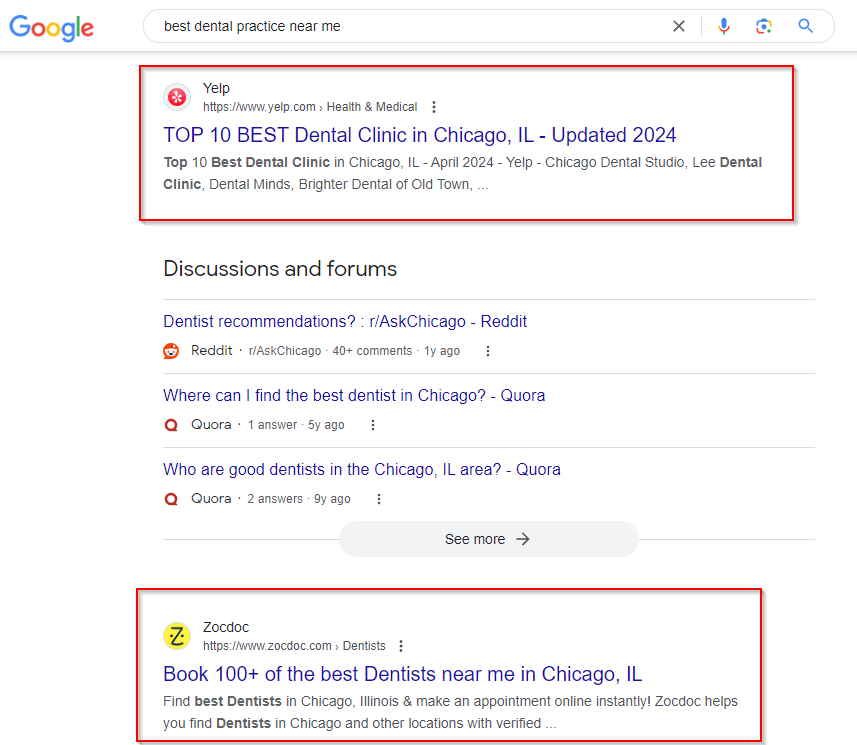
Listing your practice with the correct NAP across online directories helps Google verify your info, understand your local presence, and boost your ranking in local search results. Look for directories in the following categories:
- Review/booking platforms (Yelp, Zocdoc)
- Local business directories
- Dental associations
- Healthcare/Insurance providers
Encourage satisfied patients to leave positive reviews on Google or other review platforms
Positive reviews build trust with potential patients and result in higher search rankings, especially if you have many high patient ratings.
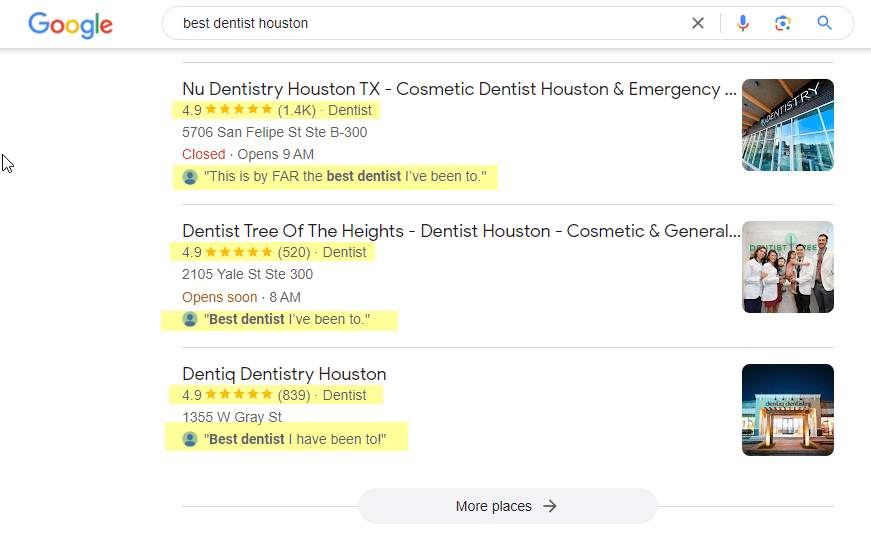
Be proactive by contacting happy patients and asking them to share their experiences. Make the process easy for them by providing direct links to your review profiles.
Always reply to patient reviews on Google! This shows that you care about feedback. It is a great way to track and address any concerns (especially negative ones) and build trust with potential patients.
Run Technical SEO & Accessibility Checks
A well-built house requires a sturdy foundation. The same goes for dental website SEO. Here are some key tips to consider:
Conduct regular website audits
Think of website audits as regular dental check-ups for your website. You should track any technical SEO issues holding your site optimization back.
Tools like SE Ranking’s Website Audit can help you identify and fix these issues before they cause real damage.
After completing the setup, head to the Issue Report tab to see a breakdown of warnings, notices, and errors, including:
- Broken links
- Missing images
- Duplicate content
- Crawl errors
- Etc.
Don’t forget to check the tooltips. These give you insights into issues and help you understand what to do next. After making the necessary fixes, click the reset option to verify that the errors have already been resolved.
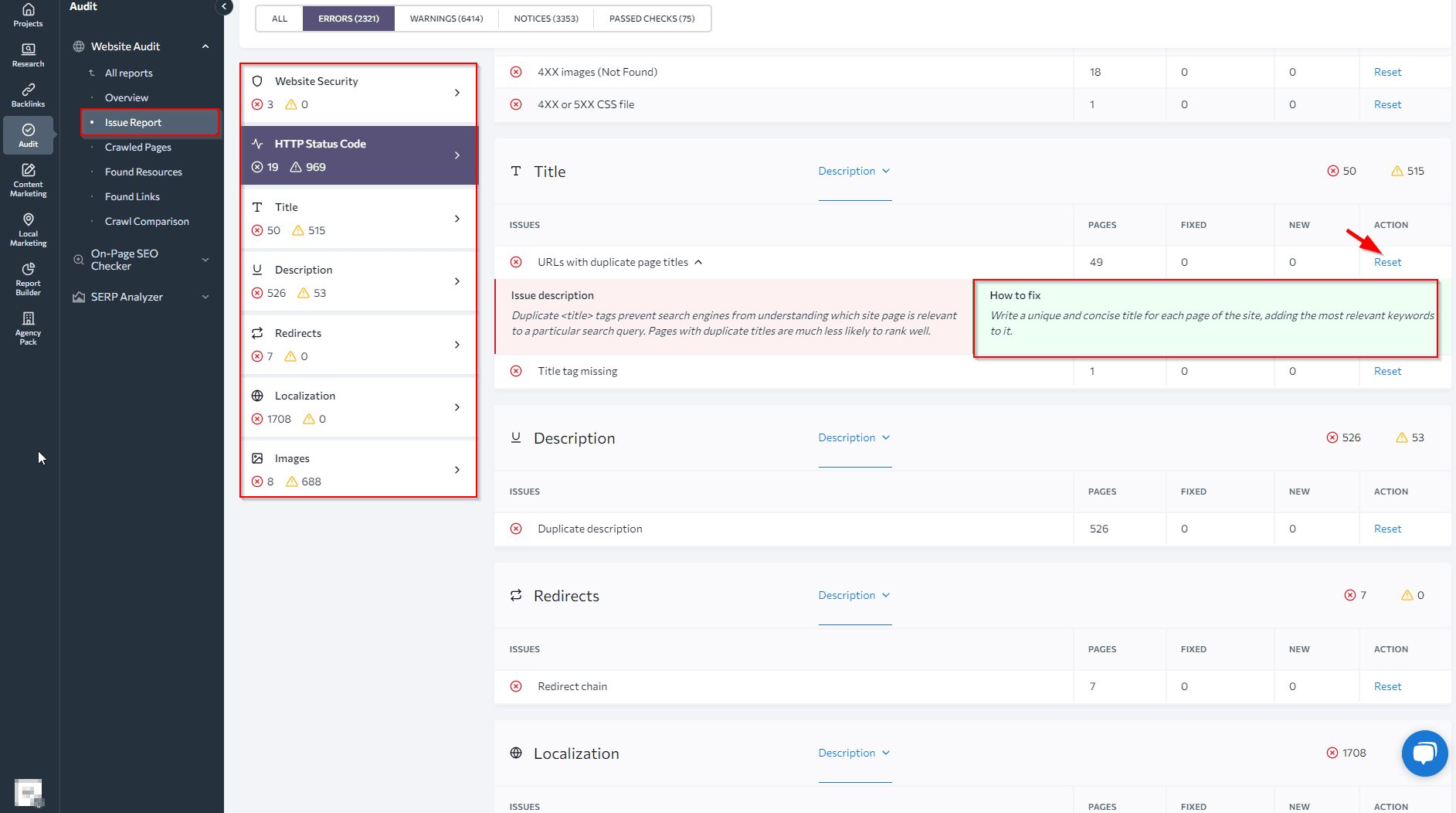
Add structured data to your website
Adding structured data (or schema markup) gives Google a roadmap to your website’s content. This can lead to richer search results and even rich snippets, where additional details appear next to your listing. Added information makes your snippet stand out in search results and attracts more clicks. For example, Shalman Dentistry in New York uses a review schema to show an average star rating.

The dental-specific information you can highlight with schema markup include:
- Medical specialty
- Forms of payment accepted
- Insurance accepted
- Hours of work
- Patient reviews
- Awards
- Languages spoken
- Etc.
For a complete list of dental-specific schema properties, visit Schema.org.
Make sure your UX is great
Your website should be easy to navigate, with a clear and organized layout. Visitors should be able to find the information they need quickly and intuitively. Here are some quick tips to make it happen:
- Make important pages easily accessible: This includes pages with your services, contact info, and patient reviews. Users should be able to reach them from the main homepage within a click or two.
- Make user-friendliness a priority: Use intuitive menus, consistent formatting, and high-quality visuals.
- Make navigation easy: Use breadcrumbs (navigational elements that show users their location within the website structure).
- Implement accessibility best practices for a smooth experience: Implement alt text for images, proper color contrast, and keyboard-friendly forms.
Give your website a responsive design
Responsive designs automatically adjust the site’s layout to fit any device’s screen size (desktop, tablet, mobile). Modern statistics highlight that almost 58% of worldwide traffic comes from mobile devices. So, double-check to see if all your website content, buttons, and forms are visible and clickable on every screen size. Smartphone users shouldn’t have to zoom in or experience roadblocks when looking for crucial information or engaging with calls to action.
Websites like LA Dental Clinic and Dentologie have this down to a tee. Their sites look sleek and work well on any screen.
For more details, check out our mobile optimization guide.
Build Your Social Media Presence
Your online presence should align with where your patients are. This means:
- Having active profiles on social media platforms that matter most to your local community. Some examples include Facebook, Instagram, TikTok, X (Twitter), or wherever your potential patients are scrolling and engaging. This allows you to share valuable content and connect with potential patients in your local area.
- Engaging your social media followers with valuable promotional material. You’ll need to go beyond having a profile. Consider sharing informative dental health tips, showcasing patient testimonials (with permission!), and informing your followers of any promotions or events (like a free dental hygiene seminar). This builds trust and positions you as a dental health expert.
For example, check out Dentologie’s Facebook page, They constantly share helpful info, fun office photos, and events.
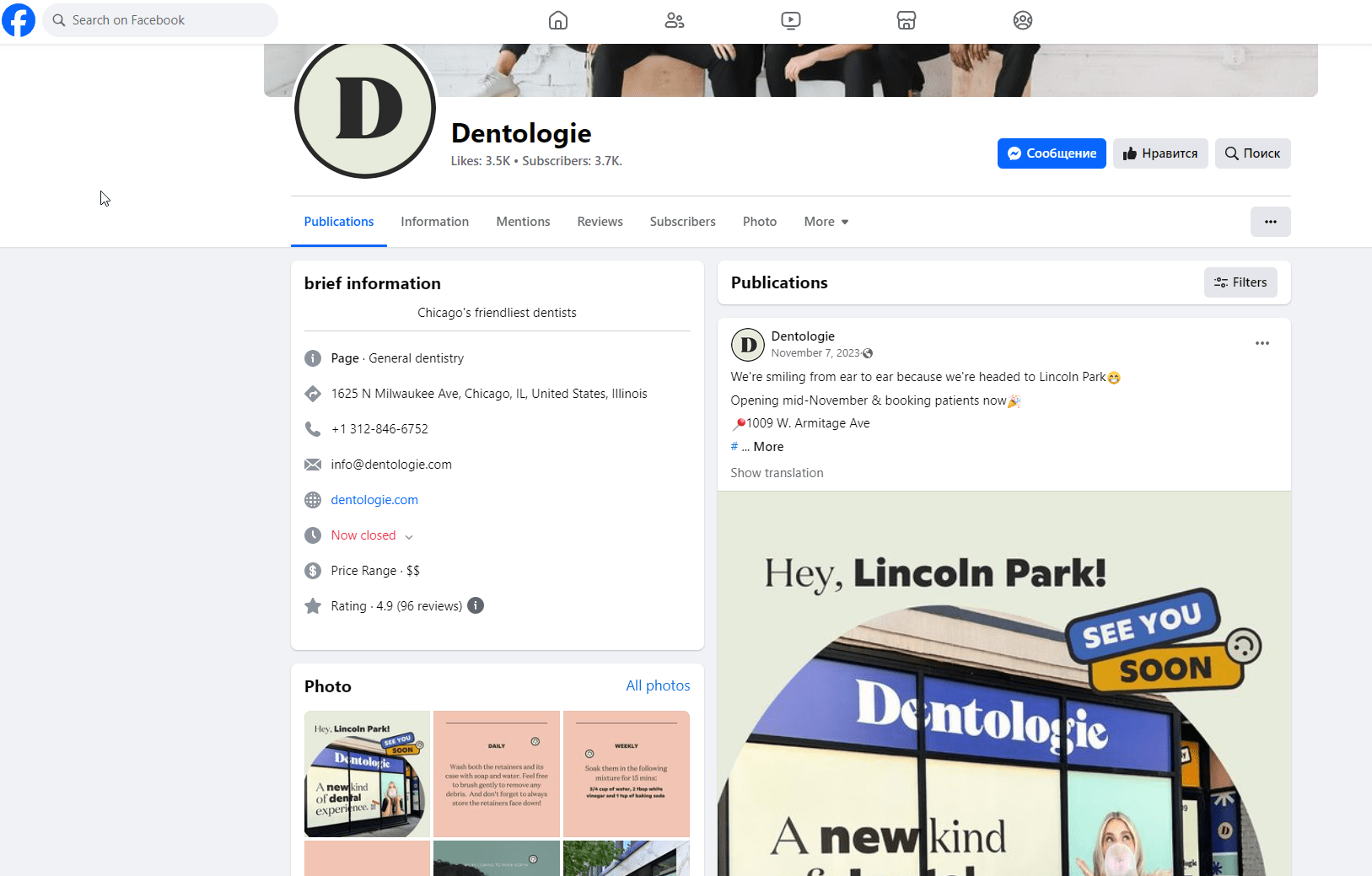
Please note! Active social media profiles with valuable content contribute to your brand’s visibility in search engine results pages (SERPs). When someone searches for your practice online, your social media profiles may appear next after your website. Your social media presence can also contribute meaningfully to your E-E-A-T strategy. Sharing valuable content and interacting with followers positions you as an expert that patients can rely on.
LA Dental Clinic’s Instagram page is a great example. They share educational posts, answer patient questions, and engage their audience with relatable memes.
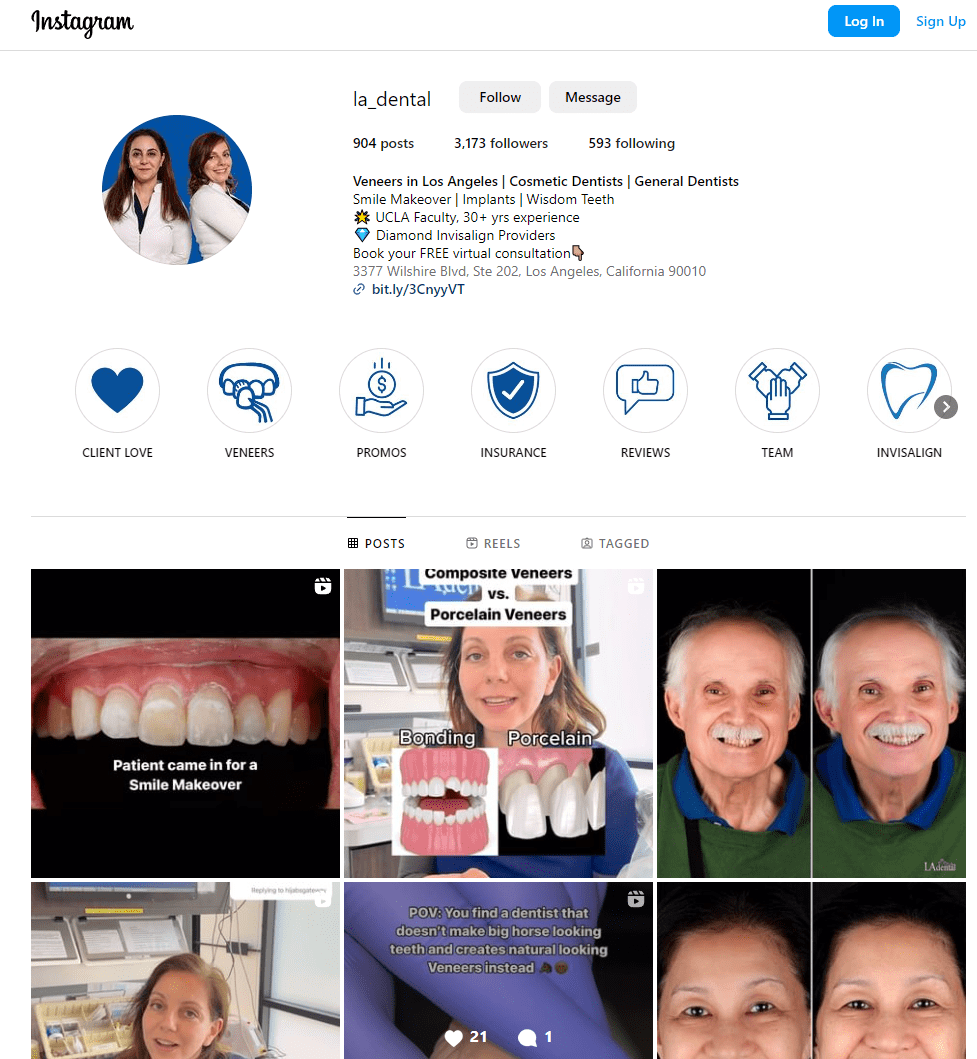
Create Video Content
Video content is a powerful tool for your dental practice’s digital marketing strategy. It’s engaging, shareable, and can convey information better than text and images. Here are some ideas for creating effective video content:
- Create informative videos on topics relevant that matter to your clients. Here’s how:
Educate viewers about common dental procedures like teeth cleanings, fillings, or teeth whitening in a clear and informative way. LA Dental Clinic’s YouTube channel is a great example of this.
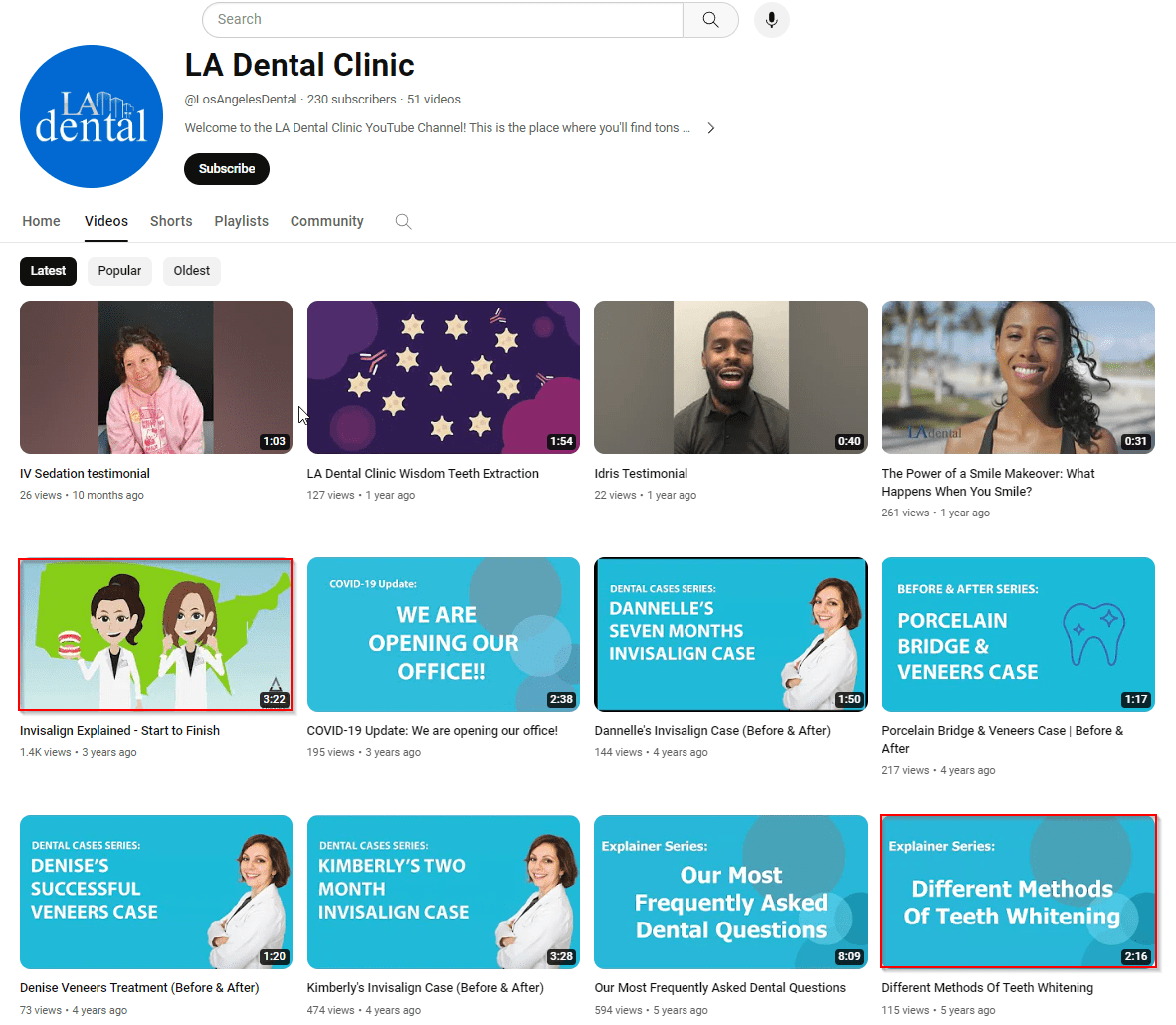
Share videos with oral hygiene tips on brushing, flossing, and maintaining good oral health at home. Create behind-the-scenes content to give patients a glimpse into your dental team’s culture, office tours, or latest equipment. Make the videos fun or thematic of your brand personality.
Dentologie’s YouTube channel is a great example of this. Its behind-the-scenes video is fun and engaging.
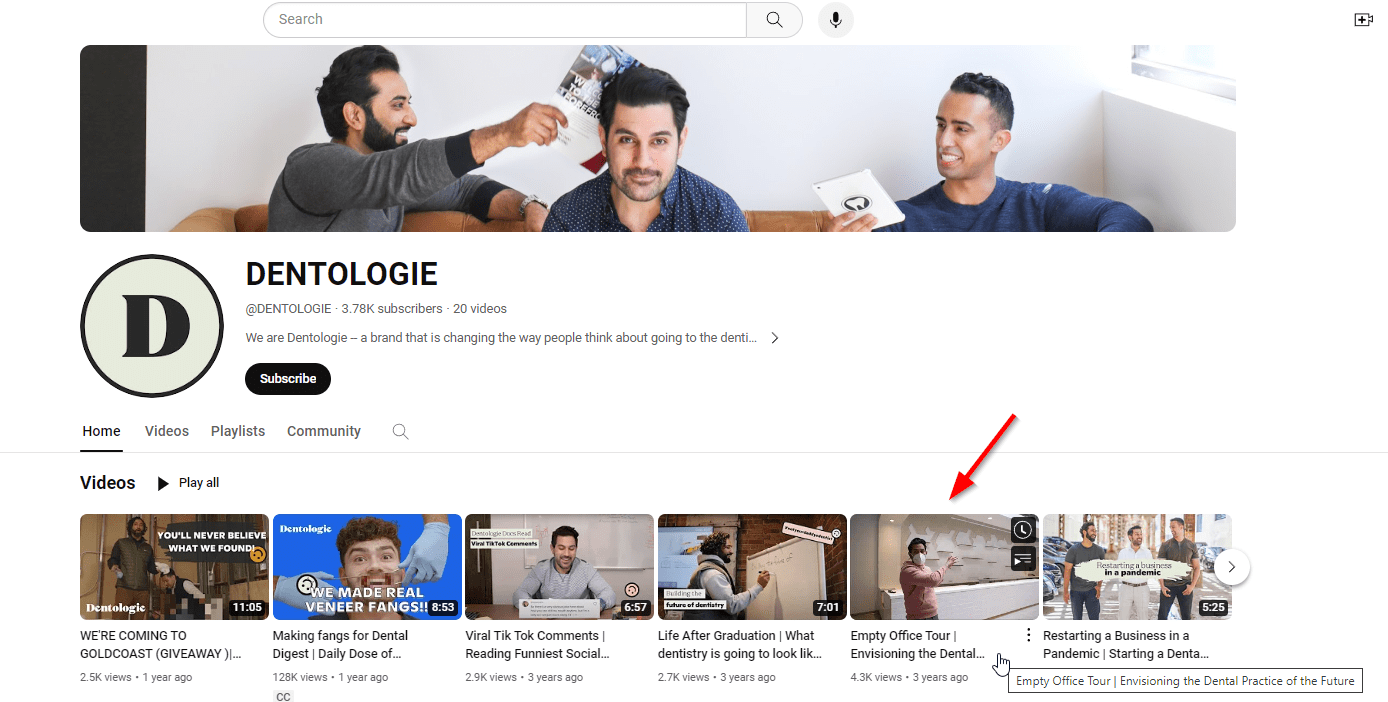
- Don’t forget about dental SEO for videos. Use these to maximize your video content’s impact by including relevant keywords in titles, descriptions, and tags. Also, provide detailed transcripts or closed captions, and promote your videos on your website and social media profiles to generate more views and engagement.
Measure Your Success
You can’t improve what you don’t measure. If you’re doing SEO for dentists, tracking your website’s performance and collecting dental SEO metrics is an absolute must. Here’s how:
Connect your website to Google Search Console
This free tool gives you invaluable insights into your website’s organic performance. You can see which keywords your site ranks for, measure website traffic, and identify and fix technical issues.
Pay special attention to the following reports and metrics it provides for SEO tracking:
- Performance report: This report tracks clicks, impressions, CTR, and keyword positions
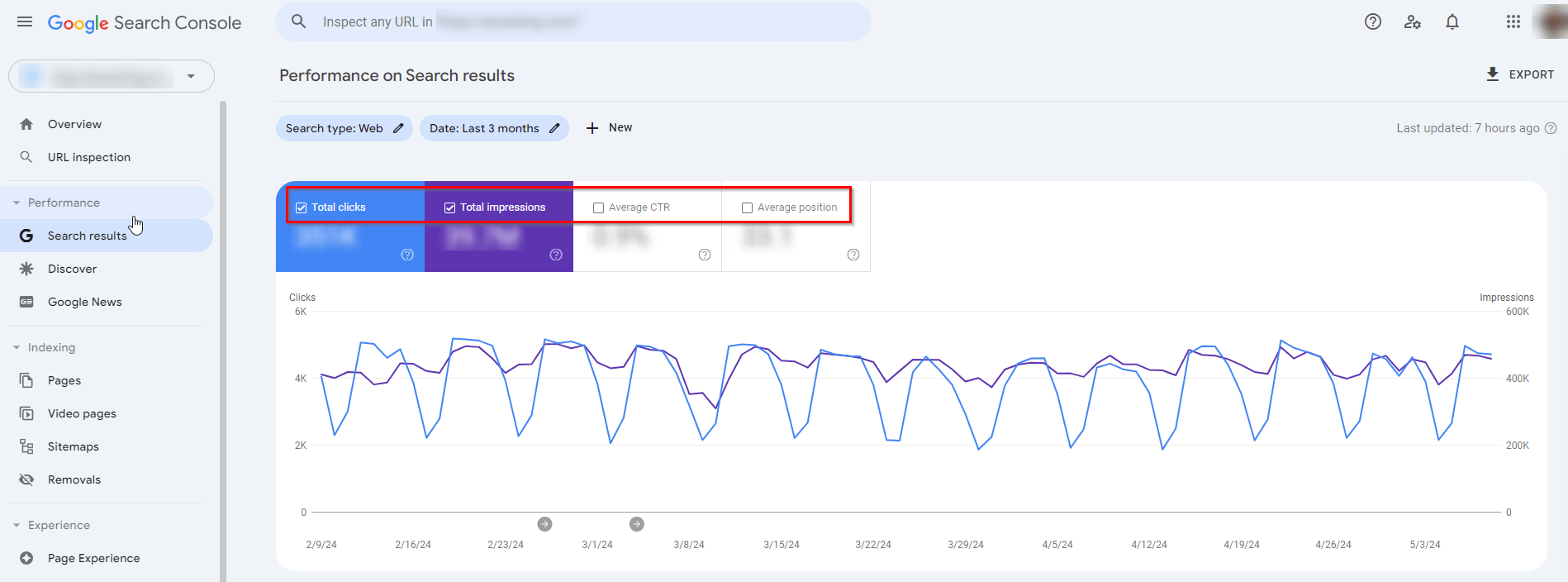
- Core Web Vitals report: This report measures your website’s loading speed, interactivity, and visual stability
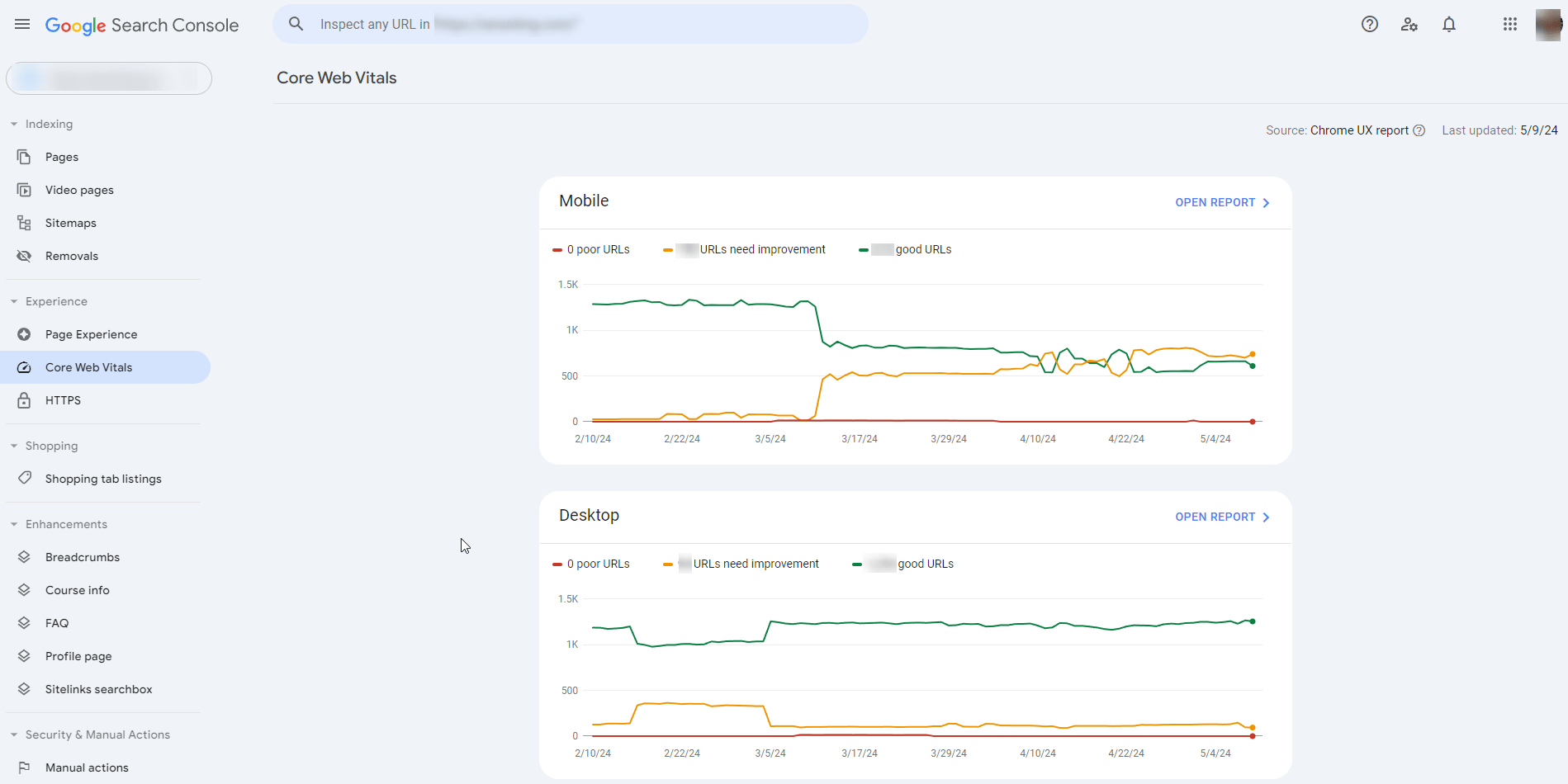
- Indexing reports: These reports identify how many URLs on your site have been crawled and indexed by Google. Use them to find any issues preventing these pages from being indexed.
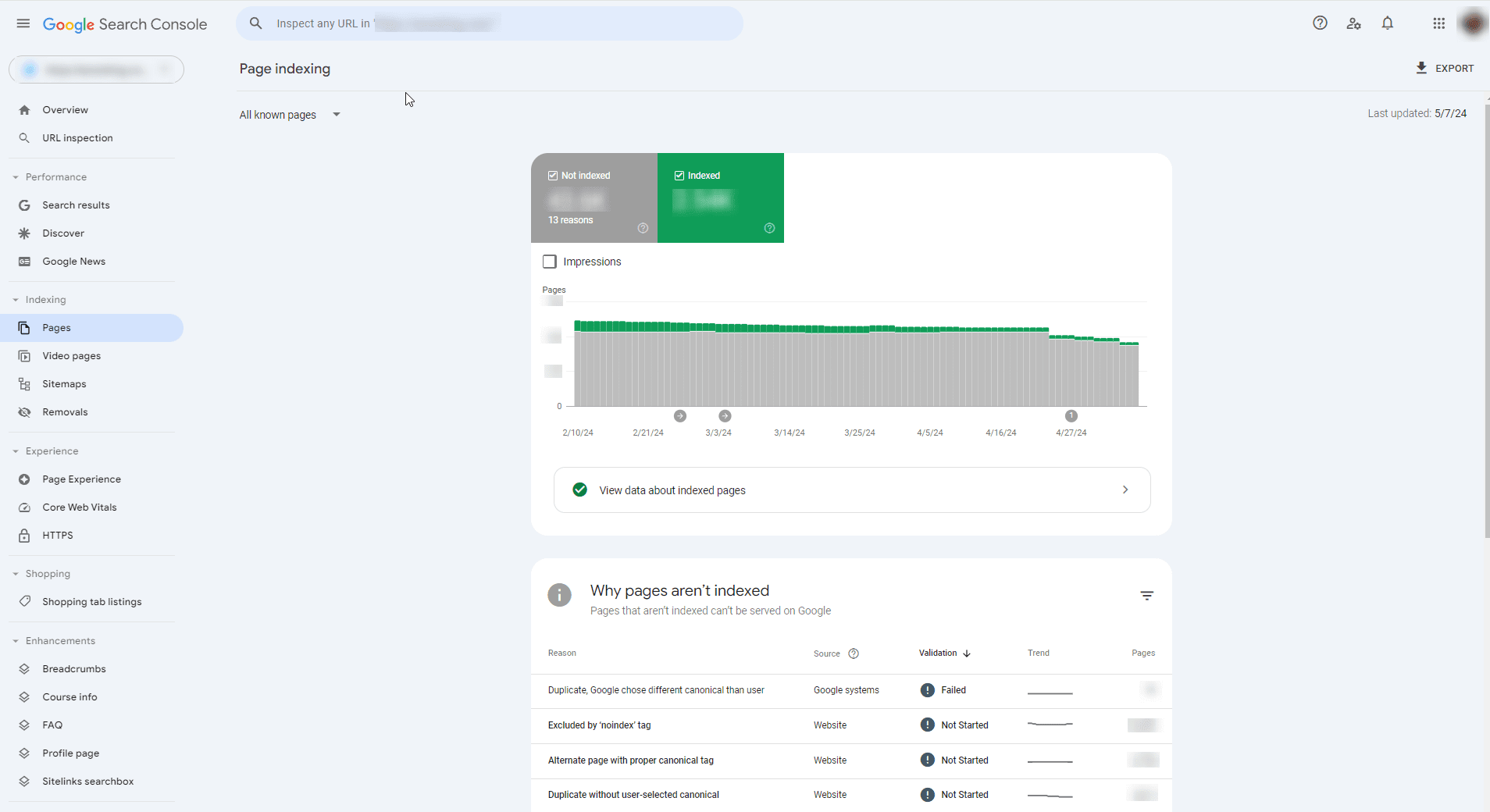
Learn how to set up Google Search Console correctly and discover all GSC’s tools and reports by reading our ultimate Google Search Console guide.
Use Google Analytics 4
This SEO tracking tool can help you track website traffic, user behavior, and page-specific performance. Start by focusing on two key metrics: organic traffic (visits to your site without paid clicks) and conversion rate (the percentage of visitors who take a desired action, like booking an appointment or contacting you).
To see organic traffic in GA4:
- Go to the main dashboard and click on Reports in the left-hand menu.
- Navigate to the Life cycle section, then click Acquisition > Traffic acquisition.
- Scroll down to see more traffic data broken down by channel.
- Click Add filter + to open the Build filter menu.
- Set the filter conditions:
- Select Session default channel group under Dimension
- Select exactly matches under Match Type
- Select Organic Search under Value
- Click Apply to filter the report and isolate organic search traffic data.
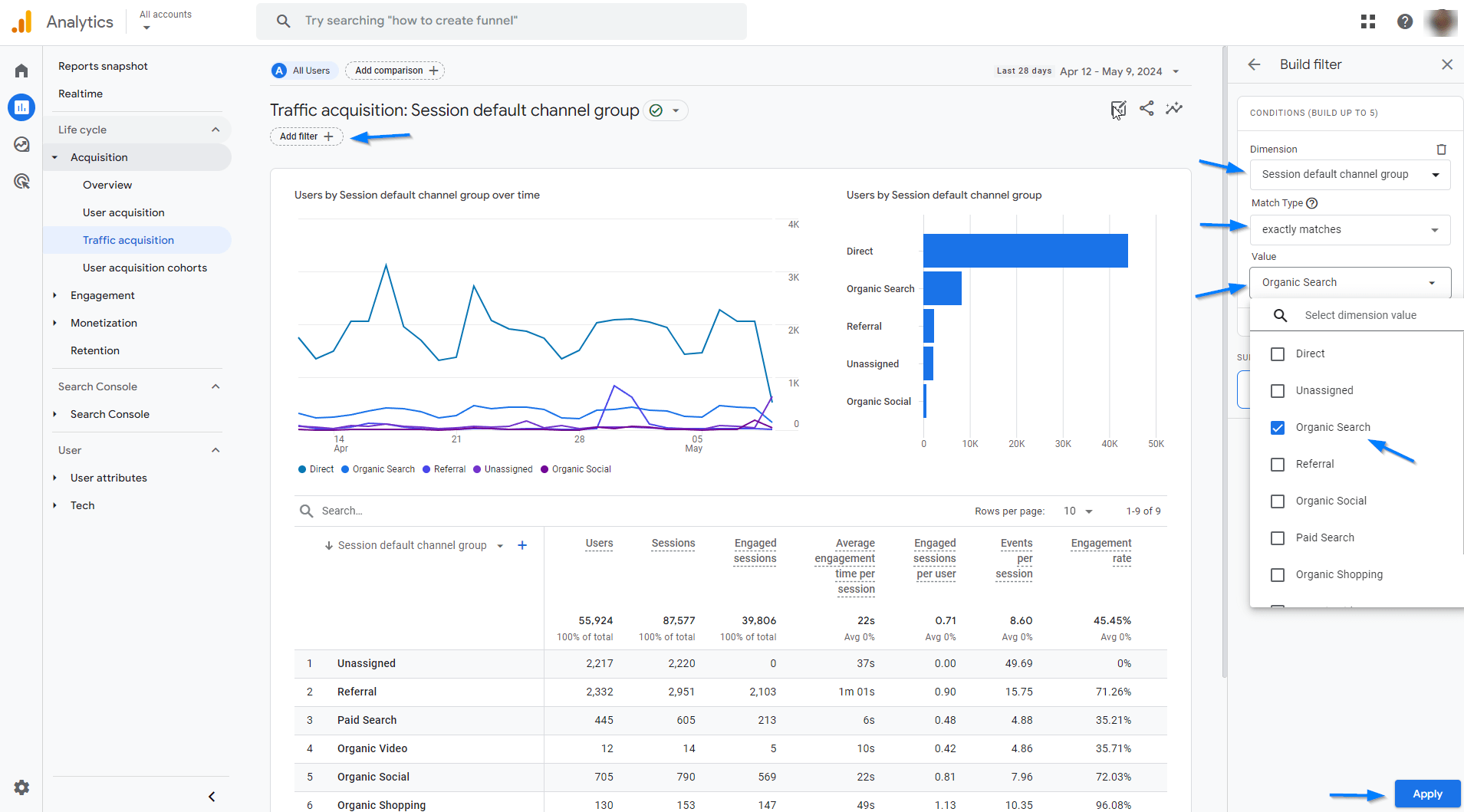
The report will now display your website’s organic search traffic metrics.
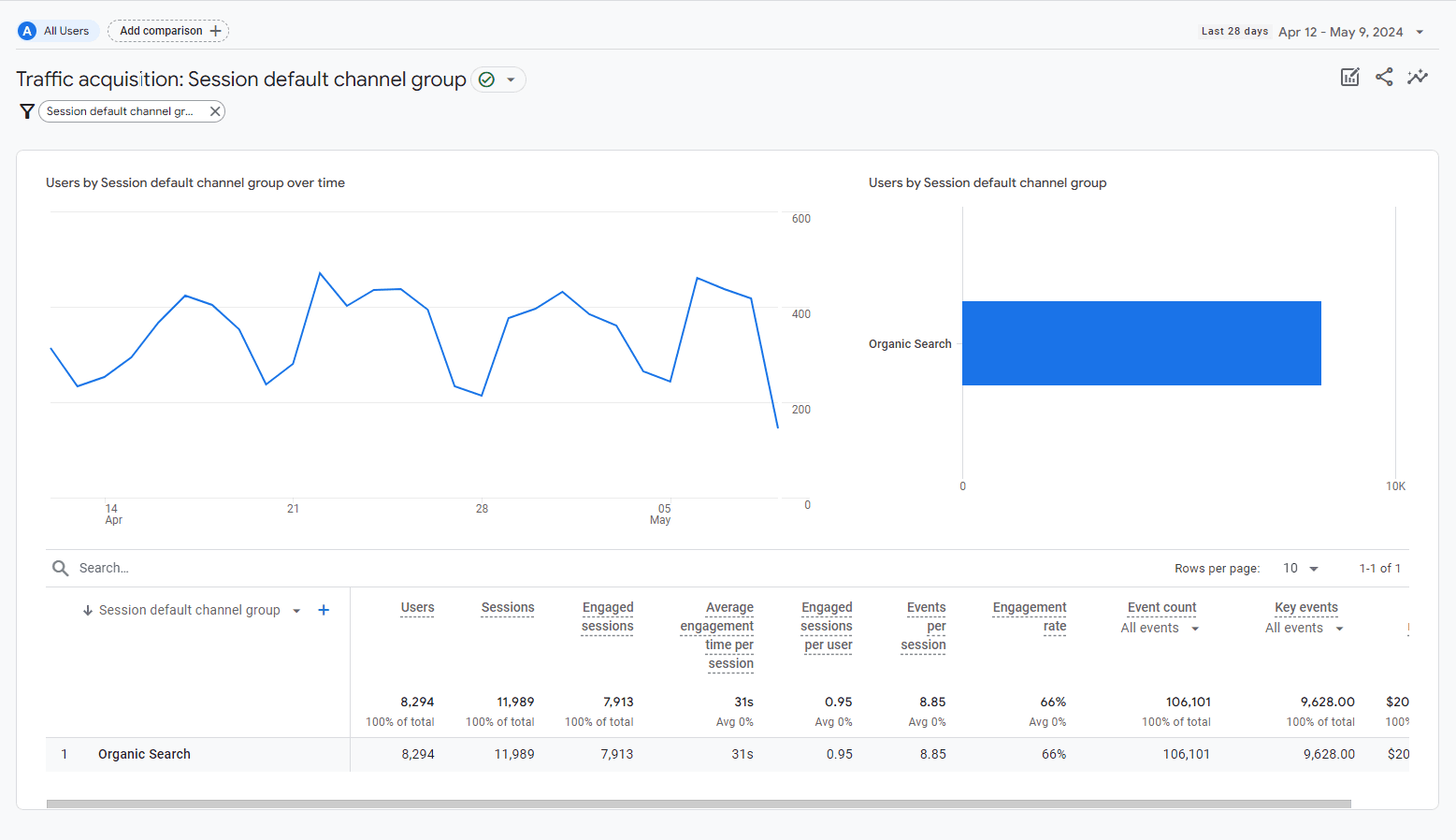
To track conversions, go to Engagement > Conversions. It will display how your tracked events perform, including conversions, total users, and total revenue generated from paid events.
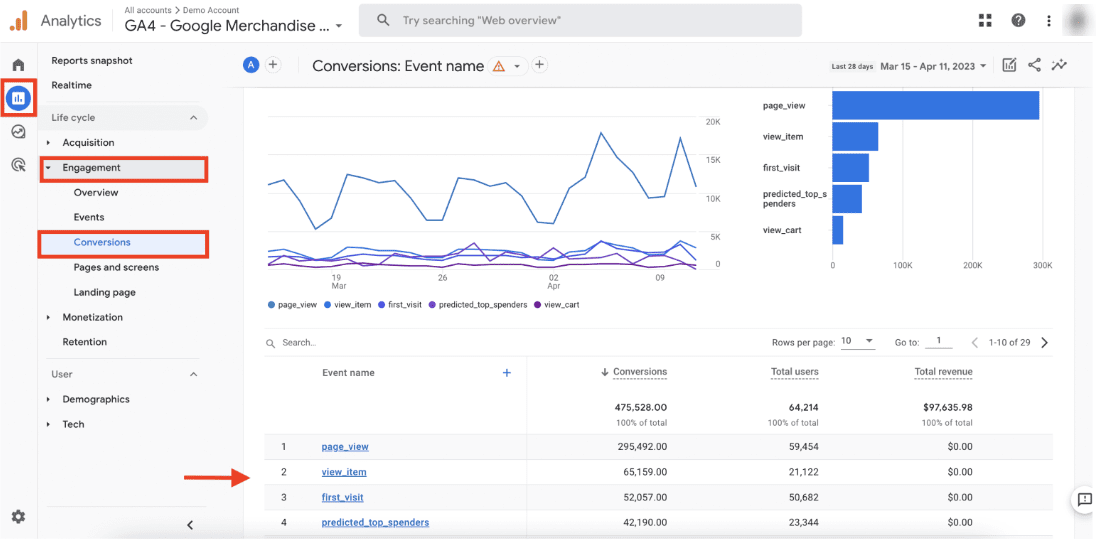
Check out our Google Analytics setup guide for tips on how to get started. For a comprehensive walkthrough, explore our guide on how to use Google Analytics for SEO.
Track your website’s SEO performance with SE Ranking
Focusing on tracking capabilities gives you more insights into your SEO progress. SE Ranking’s SEO Checker tools are great for this.
For example, you can use SE Ranking’s Local Marketing Tool to track local SEO performance. Here is a full breakdown of its functionality:
- Monitor Google Business Profile listings across multiple locations
- Receive comprehensive audits of business listing issues
- Get recommendations on profiles, listings, and reviews
- Track keyword rankings in local search results
- Analyze the local SEO performance of your competitors
- Learn how customers find and engage with your locations
- Evaluate NAP data consistency and accuracy
- Analyze and reply to reviews directly from the SE Ranking platform
- And more
For tracking keyword rankings across all major search engines like Google, Bing, Yahoo, or YouTube, use the Rank Tracker tool. It can analyze dental SEO keywords and identify search volume, difficulty, traffic forecasts, SERP features, content scores, and more.
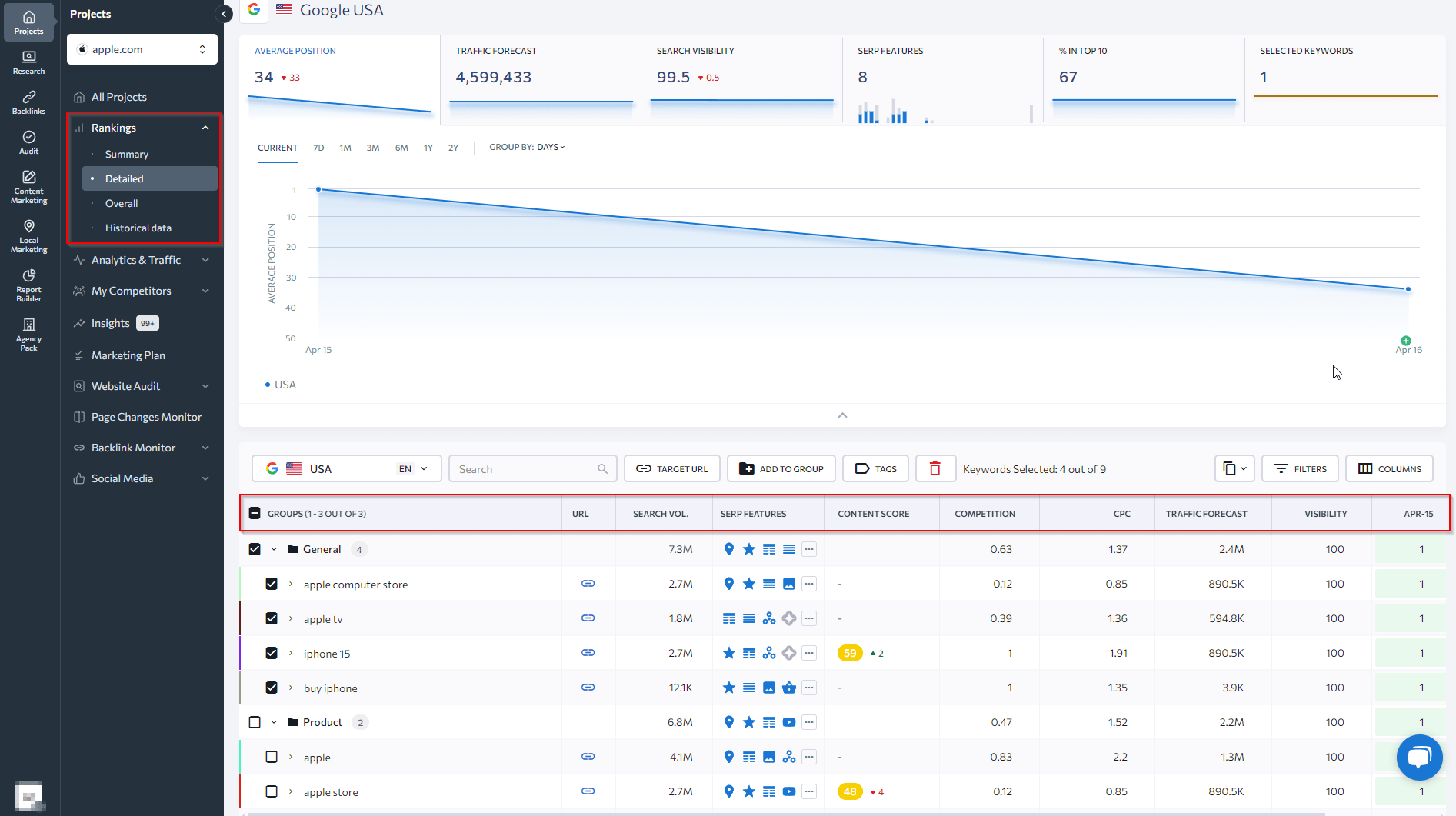
You can monitor your website’s health by running a technical SEO analysis with our Website Audit tool. This will give you an idea of what needs your attention.
To get started, specify your website’s URL. Give the system a few minutes to collect data on your site’s health. You’ll see the following metrics after it is done:
- Your website’s overall health score. The tool generates your health score by assessing the number and severity of issues found during audits.
- Reports on Core Web Vitals (a set of quality metrics based on user experience)
- The list of top SEO issues
- Page indexation status (The number of unindexed pages)
- Domain metrics
- HTTP status codes (Messages from servers that tell you how your requests were received)
- Link attributes, meta robots tags, and more.
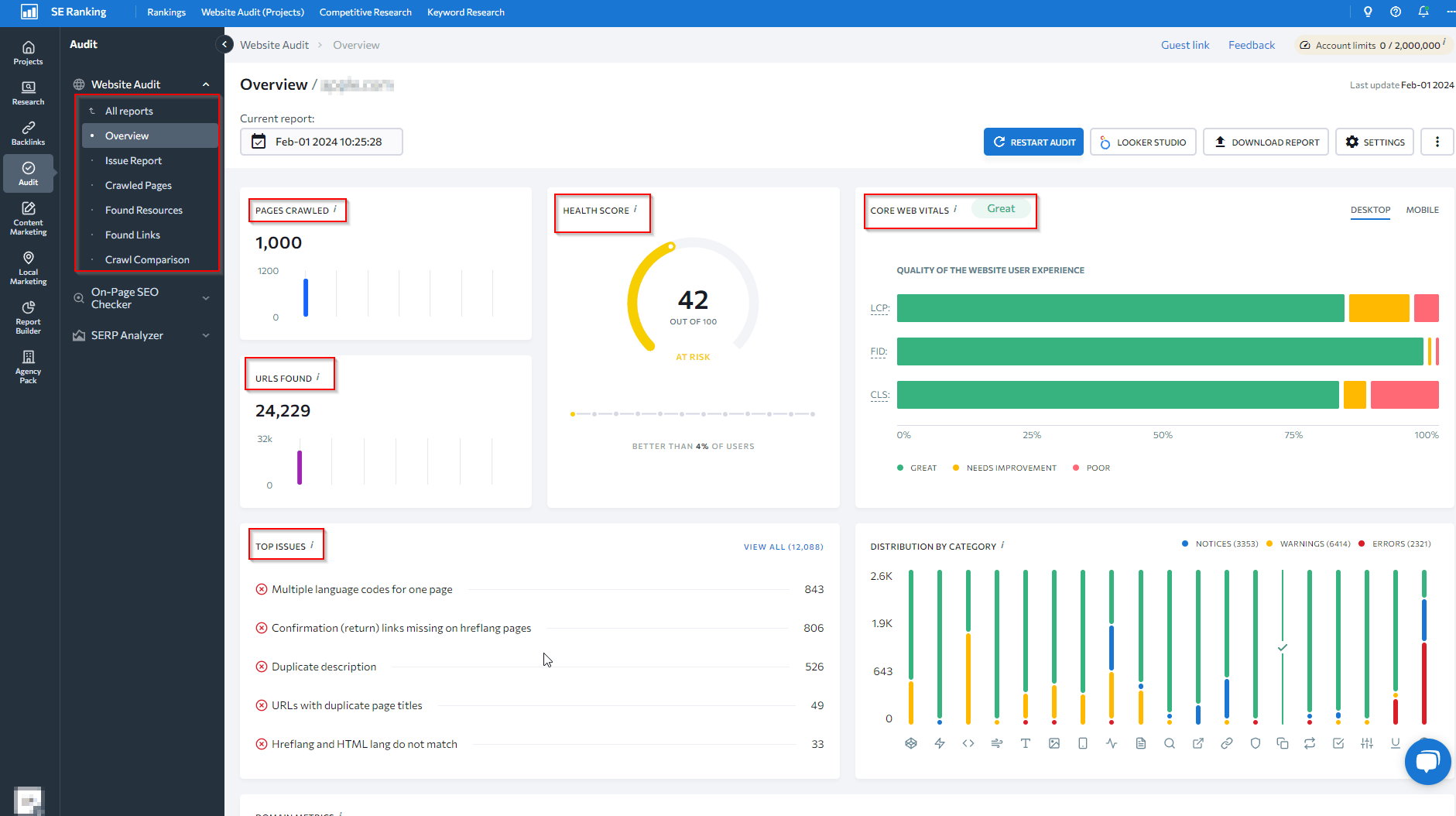
You can also compare website audit reports over time to see the impact of your dental website SEO efforts. This is how to identify what’s working and where to focus next.
Try doing a website audit with SE Ranking now!
How to implement SEO for dentists
Ready to attract more patients through search engines? Here are two effective ways to implement SEO for dental practices:
Option #1: Hire a dental SEO company
If you want to improve your online presence but lack time or expertise, let the dental SEO experts handle it. A dedicated dental SEO agency can create a tailored dental SEO strategy for your practice. You can find an agency that provides dental SEO services for your practice in our Expert Agency catalog. It contains a curated list of the best SEO agencies.
Use the Catalog’s filters to narrow down your options. Specify your location, select local SEO services, choose Healthcare as your industry, and filter by team size or languages if needed. This will generate a list of top-notch SEO agencies in your industry.
Visit agency profiles and websites to learn about their expert services, experience, and approach. Read case studies, testimonials, and pricing to ensure they meet your expectations. If interested, contact them directly through our site by submitting a form.
Choosing the right SEO agency is a big decision. For more tips, red flags, and key questions to ask, read our guide on choosing the best-fit SEO agency.
Option #2: Implement SEO yourself
Doing SEO for dentists yourself can be a good alternative if you have a limited budget but ample time. However, you should still equip yourself with SEO solutions that offer everything you need to take charge of your efforts.
For example, you can do each SEO task discussed above with the help of our SEO platform. Our comprehensive SEO toolkit has robust features, extensive data limits, high-quality datasets, and useful integrations to bolster your SEO strategy. Here’s how to use SE Ranking effectively:
- Use the Keyword Research tool to identify the keywords patients use to find dentists in your area.
- Use Rank Tracker to monitor your rankings for relevant keywords and identify areas for improvement.
- Use the Local Marketing tool to track business rankings in local search and optimize your Google Business Profile listing and other local directories. This increases the online visibility of your dental practice.
- Use the Competitive Research tool to spy on your competitors’ organic dental SEO strategies, see how you rank in search results compared to them, and analyze and get insights.
- Use the Website Audit tool to monitor your website’s health, identify technical SEO issues, and receive actionable recommendations for improvement.
- Use the Backlink Checker to uncover link-building opportunities that can improve your website’s authority and ranking potential.
As you begin your SEO journey, we know you don’t want to buy a pig in a poke. Take advantage of our 14-day trial to explore our services. You will also appreciate our generous data limits and affordable pricing plans.
And for the final point? Dental website SEO doesn’t have to be a mystery. Our platform’s extensive knowledge base and numerous interactive resources make getting started easy. Take a moment to check them out:
Dental SEO: Final Notes
SEO for dental practices is all about the long process. Investing in SEO for dental websites is an investment in the future of your practice. It takes dedication, but the payoff is that you will attract more dental patients who trust in your practice. It is totally worth it.
With the tips and strategies outlined above, you’ll be well-equipped and on your way to attracting more patients and building a solid reputation. The sooner you begin, the sooner you’ll see more smiles walking through your door.
So, are you ready to grow your practice online? Let’s do this!
